Paul van Yperen's Blog, page 228
July 18, 2019
Jodie Foster
American actress, director, and producer Jodie Foster (1962) has received two Academy Awards, three British Academy Film Awards, two Golden Globe Awards, a Screen Actors Guild Award and the Cecil B DeMille Award. A child prodigy, Foster began her professional career at the age of 3. Foster's breakthrough came at 14 with Martin Scorsese's psychological thriller Taxi Driver (1976). She played a child prostitute, for which she received an Oscar nomination. As an adult she won new acclaim with The Accused (1988), The Silence of the Lambs (1991), and Nell (1994). She later starred in four thrillers, Panic Room (2002), Flightplan (2005), Inside Man (2006) and The Brave One (2007), which were commercially successful and well-received by critics. She has focused on directing in the 2010s.
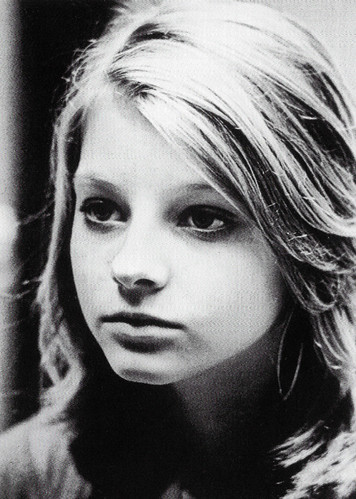
British postcard by Music & Movie Stars Ltd. Publishers, no. MMS 036. Jodie Foster in Taxi Driver (Martin Scorsese, 1976).
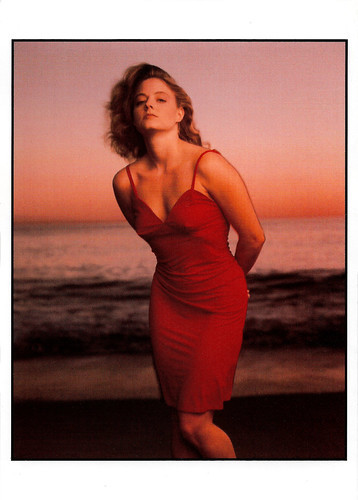
American postcard by Fotofolio, no. Z325. Photo: Annie Leibovitz. Caption: Jodie Foster, Malibu, California, 1988. Proceeds from the sale of this card donated to AIDS organizations.
A prostitute at the tender age of 12
Jodie Foster was born Alicia Christian Foster in 1962 in Los Angeles. She is the daughter of Evelyn Ella 'Brandy' (Almond), a producer, and Lucius Fisher Foster III, an Air Force lieutenant colonel and real estate broker. She is the younger sister of Buddy Foster, Cindy Foster Jones and Connie Foster, who all also acted. Brandy had filed for divorce in 1959 after having three children with Lucius, but the exes had a brief re-encounter in 1962 which resulted in Alicia's birth.
Her older siblings nicknamed her Jodie, a name she has used in her profession. She started her career in a Coppertone Suntan Lotion commercial when she was 3 years old and made commercials for four years. She made her debut as an actress in the TV series Mayberry R.F.D. (1968), on which her brother, Buddy Foster, was a regular. She stayed very busy as a child actress, working on television programs such as The Doris Day Show (1968), Adam-12 (1968), The Courtship of Eddie's Father (1969), The Partridge Family (1970), Bonanza (1972), and Gunsmoke (1969-1972).
After her film debut in Disney's Napoleon and Samantha (Bernard McEveety, 1972), Foster was much in demand. Her film roles included playing Raquel Welch 's daughter in Kansas City Bomber (Jerold Freedman, 1972) and a tomboy in Alice Doesn't Live Here Anymore (Martin Scorsese, 1974) starring Ellen Burstyn. She starred as Addie Pray on the short-lived television series Paper Moon (1974), which was originally a film by Peter Bogdanovich starring Tatum O'Neal.
Jodie first drew attention from critics with her appearance in Martin Scorsese's Taxi Driver (1976) alongside Robert De Niro and Harvey Keitel, where she played a prostitute at the tender age of 12. Her sister, Connie Foster, was her stand-in during the more explicit scenes. She received her first Oscar nomination as Best Supporting Actress for her role.
She was 12 turning 13 during production of The Little Girl Who Lives Down the Lane (Nicolas Gessner, 1976), for which she won the Saturn Award for Best Actress. Foster went on to have a very successful career in her early teens with leading roles in Bugsy Malone (Alan Parker, 1976) as the mini-vamp Tallulah, and the Disney films Freaky Friday (Gary Nelson, 1976) with Barbara Harris, and Candleshoe (Norman Tokar, 1977) opposite David Niven and Helen Hayes.
Fluent in French by age 14, she spoke her own lines in the French film Moi, fleur bleue (Eric Le Hung, 1977) with Jean Yanne and Sydne Rome . She also co-starred in the Italian comedy Casotto (Sergio Citti, 1977) with Catherine Deneuve . The last film she made during this era was the coming-of-age drama Foxes (Adrian Lyne, 1980), before enrolling at Yale University.
In 1981, during her freshman year at Yale, she was attached to a worldwide scandal when a crazed and obsessed fan named John Hinckley stalked her and attempted to assassinate President Reagan. When captured, Hinckley insisted he'd done it to impress Foster - a re-creation of a similar incident in Taxi Driver.
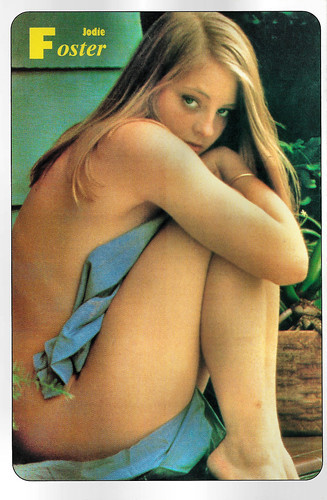
Italian postcard in the Le più belle del mondo series by Tele Tutto, no. 11.
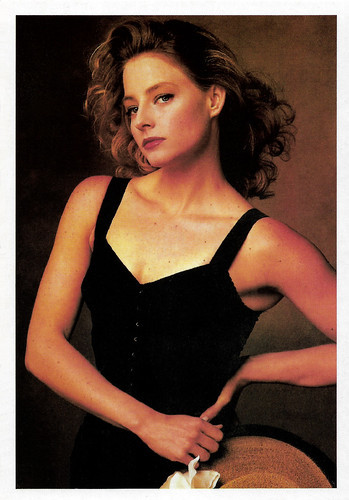
Postcard, no. 135.
A waitress who is gang-raped in a bar
In 1985, Jodie Foster graduated magna cum laude from Yale University with a degree in literature. She resumed her acting career and appeared in the comedy drama The Hotel New Hampshire (Tony Richardson, 1984) opposite Rob Lowe and Nastassia Kinski , and based on the novel by John Irving. In France, she appeared in the historical drama Le sang des autres/The Blood of Others (Claude Chabrol, 1984) based on the novel by Simone de Beauvoir.
Foster sought a breakthrough role that would return her to stardom. After appearing in a few obscure films with limited release, she landed an audition for The Accused (Jonathan Kaplan, 1988). She was cast in the part of Sarah Tobias, a waitress who is gang-raped in a bar during a night of partying and teams up with a lawyer played by Kelly McGillis to prosecute the attackers. This performance earned her an Academy Award for Best Actress, but despite the Oscar win, Jodie still hadn't re-established herself as a bankable star.
Her next film, Catchfire (Dennis Hopper, 1990), went straight to video, and she had to campaign hard to get her next good role. In 1991, she starred as Clarice Starling, an FBI trainee assisting in a hunt for a serial killer in The Silence of the Lambs (Jonathan Demme, 1991) with Anthony Hopkins. The film was a blockbuster hit, winning Jodie her second Academy Award for Best Actress and establishing her as an international film star.
With the wealth and fame to do anything she wanted, Jodie started directing. She made her directorial debut with Little Man Tate (Jodie Foster, 1991), about the tribulations of a child genius. It was followed by Home for the Holidays (Jodie Foster, 1995) with Holly Hunter, Anne Bancroft and Robert Downey Jr. These films were critically acclaimed but did not do well at the box office, and she proved to be a far more successful actress than she was a director.
On the set of Sommersby (Jon Amiel, 1993) with Richard Gere , she met Cydney Bernard and was in a serious relationship with her until they broke up in 2008. 1994 was a huge triumph for her acting career. She first played a sexy con artist in the successful Western comedy Maverick (Richard Donner, 1994) with Mel Gibson and James Garner.
She made her debut as producer in 1994 with Nell (Michael Apted, 1994). She also played the title role opposite Liam Neeson and Natasha Richardson. For her compelling performance as a wild, backwoods hermit who speaks an invented language and must return to civilisation, Jodie was nominated for another Academy Award and won a Screen Actors Guild Award as Best Actress.
Although she was working far less frequently as an adult than she did as a child, the films she turned out were commercially successful and critically acclaimed. Her next big screen role was in the science fiction drama Contact (Robert Zemeckis, 1997) opposite Matthew McConaughey. She played a scientist who receives signals from space aliens. The film was a huge hit and brought her a Golden Globe nomination.
She had to pull out of Double Jeopardy (Bruce Beresford, 1999) because she became pregnant, and was replaced by Ashley Judd. In 1999, her son Charles Foster, with partner Cydney Bernard, was born. She returned to work four months later in order to begin filming Anna and the King (Andy Tennant, 1999), a non-musical remake of The King and I (Walter Lang, 1956). The film was only modestly received in the U.S. but was successful in the rest of the world.

British postcard by Heroes Publishing Ltd., London, no. SPC2540.
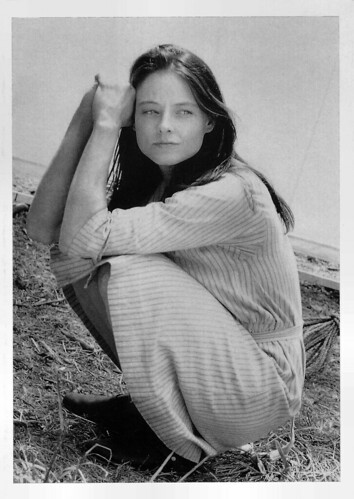
Canadian postcard by Canadian Postcard, no. A-253. Jodie Foster in Nell (Michael Apted, 1994).
Playing tough women in mainstream thrillers
Jodie Foster returned to work four months after giving birth to her second son Kit Foster, but she shut down her production company Egg Pictures in late 2001 to spend more time with her children. She headlined the thriller Panic Room (David Fincher, 2002), which co-starred Kristen Stewart. The film was a smash box-office hit and gave Jodie a $30 million opening weekend, the biggest of her career yet.
She then appeared in two low-profile projects: the independent film The Dangerous Lives of Altar Boys (Peter Care, 2002) and the French film Un long dimanche de fiançailles (Jean-Pierre Jeunet, 2004) with Audrey Tautou and Gaspard Ulliel.
She returned to making Hollywood mainstream films, first with Flightplan (Robert Schwentke, 2005), in which she played a woman whose daughter disappears on an airplane that she designed. Once again Jodie proved herself to be a box-office draw, and the film was a worldwide hit.
The following year, she starred in another hit, the bank heist thriller Inside Man (Spike Lee, 2006) with Denzel Washington and Clive Owen. Jodie was on a roll. Her next film was the revenge thriller The Brave One (Neil Jordan, 2007), which once again opened at #1 at the box office and earned her another Golden Globe nomination for Best Actress.
Following this succession of thrillers that all had her playing tough women, Jodie returned to the comedy genre in Nim's Island (Jennifer Flackett, Mark Levin, 2008) with Gerard Butler and Abigail Breslin. She reunited with Mel Gibson in the comedy The Beaver (Jodie Foster, 2011). Strong roles followed in Carnage (Roman Polanski, 2011) with Kate Winslet , and the Sci-Fi film Elysium (Neill Blomkamp, 2013) with Matt Damon.
In 2013, she received the Cecil B. DeMille award at the Golden Globe Awards. In April 2016, Jodie Foster married Alexandra Hedison. In July that year, John Hinckley was released after almost 35 years of commission to St. Elizabeth's Mental Institution. Lately, she focused on directing and made the film Money Monster (2016), as well as episodes for the TV series Orange Is the New Black, House of Cards, and Black Mirror.
Jodie Foster's most recent film is Hotel Artemis (Drew Pearce, 2018) in which she runs a high-security, members-only hospital for high-rolling criminals in Los Angeles.
Trailer Taxi Driver (1976). Source: YouTube Movies (YouTube).
Trailer Hotel Artemis (2018). Source: Zero Media (YouTube).
Sources: Hal Erickson (AllMovie), Wikipedia and .

British postcard by Music & Movie Stars Ltd. Publishers, no. MMS 036. Jodie Foster in Taxi Driver (Martin Scorsese, 1976).

American postcard by Fotofolio, no. Z325. Photo: Annie Leibovitz. Caption: Jodie Foster, Malibu, California, 1988. Proceeds from the sale of this card donated to AIDS organizations.
A prostitute at the tender age of 12
Jodie Foster was born Alicia Christian Foster in 1962 in Los Angeles. She is the daughter of Evelyn Ella 'Brandy' (Almond), a producer, and Lucius Fisher Foster III, an Air Force lieutenant colonel and real estate broker. She is the younger sister of Buddy Foster, Cindy Foster Jones and Connie Foster, who all also acted. Brandy had filed for divorce in 1959 after having three children with Lucius, but the exes had a brief re-encounter in 1962 which resulted in Alicia's birth.
Her older siblings nicknamed her Jodie, a name she has used in her profession. She started her career in a Coppertone Suntan Lotion commercial when she was 3 years old and made commercials for four years. She made her debut as an actress in the TV series Mayberry R.F.D. (1968), on which her brother, Buddy Foster, was a regular. She stayed very busy as a child actress, working on television programs such as The Doris Day Show (1968), Adam-12 (1968), The Courtship of Eddie's Father (1969), The Partridge Family (1970), Bonanza (1972), and Gunsmoke (1969-1972).
After her film debut in Disney's Napoleon and Samantha (Bernard McEveety, 1972), Foster was much in demand. Her film roles included playing Raquel Welch 's daughter in Kansas City Bomber (Jerold Freedman, 1972) and a tomboy in Alice Doesn't Live Here Anymore (Martin Scorsese, 1974) starring Ellen Burstyn. She starred as Addie Pray on the short-lived television series Paper Moon (1974), which was originally a film by Peter Bogdanovich starring Tatum O'Neal.
Jodie first drew attention from critics with her appearance in Martin Scorsese's Taxi Driver (1976) alongside Robert De Niro and Harvey Keitel, where she played a prostitute at the tender age of 12. Her sister, Connie Foster, was her stand-in during the more explicit scenes. She received her first Oscar nomination as Best Supporting Actress for her role.
She was 12 turning 13 during production of The Little Girl Who Lives Down the Lane (Nicolas Gessner, 1976), for which she won the Saturn Award for Best Actress. Foster went on to have a very successful career in her early teens with leading roles in Bugsy Malone (Alan Parker, 1976) as the mini-vamp Tallulah, and the Disney films Freaky Friday (Gary Nelson, 1976) with Barbara Harris, and Candleshoe (Norman Tokar, 1977) opposite David Niven and Helen Hayes.
Fluent in French by age 14, she spoke her own lines in the French film Moi, fleur bleue (Eric Le Hung, 1977) with Jean Yanne and Sydne Rome . She also co-starred in the Italian comedy Casotto (Sergio Citti, 1977) with Catherine Deneuve . The last film she made during this era was the coming-of-age drama Foxes (Adrian Lyne, 1980), before enrolling at Yale University.
In 1981, during her freshman year at Yale, she was attached to a worldwide scandal when a crazed and obsessed fan named John Hinckley stalked her and attempted to assassinate President Reagan. When captured, Hinckley insisted he'd done it to impress Foster - a re-creation of a similar incident in Taxi Driver.

Italian postcard in the Le più belle del mondo series by Tele Tutto, no. 11.

Postcard, no. 135.
A waitress who is gang-raped in a bar
In 1985, Jodie Foster graduated magna cum laude from Yale University with a degree in literature. She resumed her acting career and appeared in the comedy drama The Hotel New Hampshire (Tony Richardson, 1984) opposite Rob Lowe and Nastassia Kinski , and based on the novel by John Irving. In France, she appeared in the historical drama Le sang des autres/The Blood of Others (Claude Chabrol, 1984) based on the novel by Simone de Beauvoir.
Foster sought a breakthrough role that would return her to stardom. After appearing in a few obscure films with limited release, she landed an audition for The Accused (Jonathan Kaplan, 1988). She was cast in the part of Sarah Tobias, a waitress who is gang-raped in a bar during a night of partying and teams up with a lawyer played by Kelly McGillis to prosecute the attackers. This performance earned her an Academy Award for Best Actress, but despite the Oscar win, Jodie still hadn't re-established herself as a bankable star.
Her next film, Catchfire (Dennis Hopper, 1990), went straight to video, and she had to campaign hard to get her next good role. In 1991, she starred as Clarice Starling, an FBI trainee assisting in a hunt for a serial killer in The Silence of the Lambs (Jonathan Demme, 1991) with Anthony Hopkins. The film was a blockbuster hit, winning Jodie her second Academy Award for Best Actress and establishing her as an international film star.
With the wealth and fame to do anything she wanted, Jodie started directing. She made her directorial debut with Little Man Tate (Jodie Foster, 1991), about the tribulations of a child genius. It was followed by Home for the Holidays (Jodie Foster, 1995) with Holly Hunter, Anne Bancroft and Robert Downey Jr. These films were critically acclaimed but did not do well at the box office, and she proved to be a far more successful actress than she was a director.
On the set of Sommersby (Jon Amiel, 1993) with Richard Gere , she met Cydney Bernard and was in a serious relationship with her until they broke up in 2008. 1994 was a huge triumph for her acting career. She first played a sexy con artist in the successful Western comedy Maverick (Richard Donner, 1994) with Mel Gibson and James Garner.
She made her debut as producer in 1994 with Nell (Michael Apted, 1994). She also played the title role opposite Liam Neeson and Natasha Richardson. For her compelling performance as a wild, backwoods hermit who speaks an invented language and must return to civilisation, Jodie was nominated for another Academy Award and won a Screen Actors Guild Award as Best Actress.
Although she was working far less frequently as an adult than she did as a child, the films she turned out were commercially successful and critically acclaimed. Her next big screen role was in the science fiction drama Contact (Robert Zemeckis, 1997) opposite Matthew McConaughey. She played a scientist who receives signals from space aliens. The film was a huge hit and brought her a Golden Globe nomination.
She had to pull out of Double Jeopardy (Bruce Beresford, 1999) because she became pregnant, and was replaced by Ashley Judd. In 1999, her son Charles Foster, with partner Cydney Bernard, was born. She returned to work four months later in order to begin filming Anna and the King (Andy Tennant, 1999), a non-musical remake of The King and I (Walter Lang, 1956). The film was only modestly received in the U.S. but was successful in the rest of the world.

British postcard by Heroes Publishing Ltd., London, no. SPC2540.

Canadian postcard by Canadian Postcard, no. A-253. Jodie Foster in Nell (Michael Apted, 1994).
Playing tough women in mainstream thrillers
Jodie Foster returned to work four months after giving birth to her second son Kit Foster, but she shut down her production company Egg Pictures in late 2001 to spend more time with her children. She headlined the thriller Panic Room (David Fincher, 2002), which co-starred Kristen Stewart. The film was a smash box-office hit and gave Jodie a $30 million opening weekend, the biggest of her career yet.
She then appeared in two low-profile projects: the independent film The Dangerous Lives of Altar Boys (Peter Care, 2002) and the French film Un long dimanche de fiançailles (Jean-Pierre Jeunet, 2004) with Audrey Tautou and Gaspard Ulliel.
She returned to making Hollywood mainstream films, first with Flightplan (Robert Schwentke, 2005), in which she played a woman whose daughter disappears on an airplane that she designed. Once again Jodie proved herself to be a box-office draw, and the film was a worldwide hit.
The following year, she starred in another hit, the bank heist thriller Inside Man (Spike Lee, 2006) with Denzel Washington and Clive Owen. Jodie was on a roll. Her next film was the revenge thriller The Brave One (Neil Jordan, 2007), which once again opened at #1 at the box office and earned her another Golden Globe nomination for Best Actress.
Following this succession of thrillers that all had her playing tough women, Jodie returned to the comedy genre in Nim's Island (Jennifer Flackett, Mark Levin, 2008) with Gerard Butler and Abigail Breslin. She reunited with Mel Gibson in the comedy The Beaver (Jodie Foster, 2011). Strong roles followed in Carnage (Roman Polanski, 2011) with Kate Winslet , and the Sci-Fi film Elysium (Neill Blomkamp, 2013) with Matt Damon.
In 2013, she received the Cecil B. DeMille award at the Golden Globe Awards. In April 2016, Jodie Foster married Alexandra Hedison. In July that year, John Hinckley was released after almost 35 years of commission to St. Elizabeth's Mental Institution. Lately, she focused on directing and made the film Money Monster (2016), as well as episodes for the TV series Orange Is the New Black, House of Cards, and Black Mirror.
Jodie Foster's most recent film is Hotel Artemis (Drew Pearce, 2018) in which she runs a high-security, members-only hospital for high-rolling criminals in Los Angeles.
Trailer Taxi Driver (1976). Source: YouTube Movies (YouTube).
Trailer Hotel Artemis (2018). Source: Zero Media (YouTube).
Sources: Hal Erickson (AllMovie), Wikipedia and .
Published on July 18, 2019 22:00
July 17, 2019
Sophia Loren's Ieri, Oggi Domani
New series alert! This Summer, I read several film books (some interesting, some great). On the coming Thursdays, I would like to share my thoughts about them at EFSP. I'll combine these 'book reviews' with a choice of our postcards.
In 'Ieri, oggi, domani', the then nearly 80 years old Sophia Loren waits for her grandchildren while preparing a Christmas dinner for her family. She opens a box full of little objects, which bring back memories of a long life and a magnificent career. The title of this memoir, which translates as 'Yesterday, today, tomorrow', refers to her famous film from 1963 in which she costarred with Marcello Mastroianni and was directed by Vittorio De Sica. In her book, she often refers to these two friends, who were as important for her career as she was for theirs. Less she writes about what her husband, producer Carlo Ponti, meant for her film career.

Dutch book cover for Sophia Loren, 'Mijn leven - Ieri, oggi, domani' (1994). Original title: 'Ieri, oggi, domani'. Translated by Edwin Krijgsman and Els van der Pluijm. Publisher: Uitgeverij-Sijthoff B.V., Amsterdam.
That famous sensual walk through the rain
The most interesting part of Sophia Loren 's film career was in the Italian cinema. During the 1950s and 1960s, she was a typical film producer's muse. Like Silvana Mangano often worked with husband Dino De Laurentiis and Claudia Cardinale with her husband Franco Cristaldi, Sophia almost always worked with Carlo Ponti.
In 1951, the 17-year old Sofia Scicolone met Ponti, then 39 and married. Ponti was a great catch. In 1941, he had had his breakthrough as a producer with the drama Piccolo mondo antico/Old-Fashioned World (Mario Soldati, 1941), which made a star of Alida Valli . In 1949 Ponti started his own production company together with Dino De Laurentiis. They worked with all the major directors of the time: De Sica, Lattuada, Rossellini, Blasetti, Visconti... Sophia wonders in retrospect if she realised how important her new companion was.
In 1949, Sofia started her career at a beauty contest in a cinema in Naples, to which she was pushed by her poor mammina. She won a prize which included a train ticket to Rome. In her memoir, Loren vividly describes how she and her mother arrived in Cinecittà, where MGM was just filming Quo Vadis?. Rome had become Hollywood on the Tiber! Director Mervyn Le Roy even offered Sofia a bit part in the film, although the only English word she could say to him was 'yes'.
In the following years, she gathered experience by posing for the very popular Fotoromanzi, the photo comics which emerged in Italy in the 1940s and expanded into the 1950s. Loren writes that the Fotoromanzo, introduced by the De Luca brothers and the Milanese company Universo, helped her to learn to express herself. For her and other young hopefuls, they formed a stepping stone to the cinema.
Was it Carlo who helped her get her first leading role in Africa sotto i mari/Africa Under the Seas (Giovanni Roccardi, 1953)? Probably, but Loren had real star appeal. In the publicity stills of her first films, she already looked sensational. A beauty with a natural talent who enjoyed Cinecittà as her wonderland.
Loren did one film after another in these years. And then came her 28th film (in four years), she was directed by Vittorio De Sica in Pizze a credito, a segment of the anthology film L'oro di Napoli (Vittorio De Sica, 1954). She played a charming Neapolitan pizza cook, who loses an emerald ring which her husband gave her. She searches for it and supposes she baked it into a pizza, but in reality she left it on her lover's nightstand. Her vivacious smile, her pronounced cleavage and her famous sensual walk through the rain while followed by her cuckolded husband made her an international star. It started a long series of films with De Sica, and soon also Hollywood was calling.

German postcard printed by Krüger, no. 902/304. Photo: Georg Michalke. Publicity still for Loren's 31nd (!) Italian film, La donna del fiume/Woman of the River (Mario Soldati, 1954).
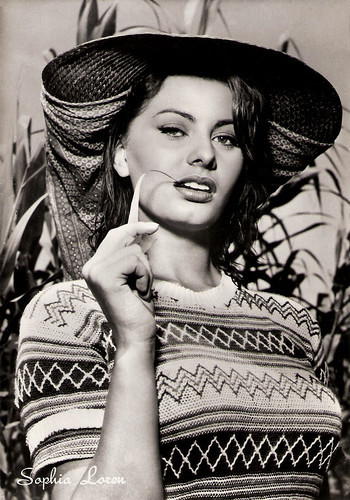
Italian postcard by Rotalfoto, Milano, no. 328. Photo: Ponti-De Laurentiis. Publicity still for La donna del fiume/Woman of the River (Mario Soldati, 1954).
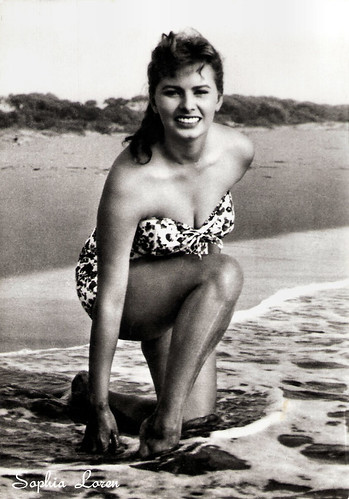
Italian postcard by Rotalfoto, Milano, no. 358.
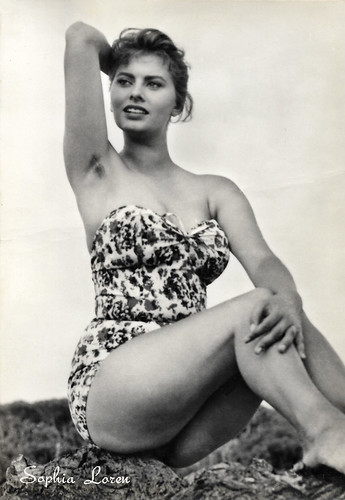
Italian postcard by Rotalfoto, Milano, no. 449. Photo: Documento Film. Publicity still for Peccato che sia una canaglia/Too Bad She's Bad (Alessandro Blasetti, 1954).
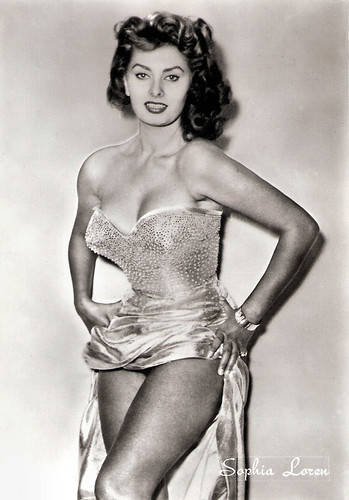
Italian postcard by Rotalfoto, Milano, no. 591.
A tough cookie from Naples
Sophia Loren writes about her encounters and films in Hollywood, but she remains a lady who does not gossip. She writes warmly about admirers as Cary Grant and Peter Sellers .
One of the few co-stars, whom she did not like was Marlon Brando , her co-star in A Countess from Hong Kong (Charles Chaplin, 1967). She describes how Brando arrives three quarters too late at the first day of shooting, how the whole crew has to wait and how Chaplin scolds him in front of the whole crew. From then on, Brando never arrived late again at the set.
Later during the production of the film, Brando made a pass at her. Loren reacted as a blazing cat and furiously hissed "Don't ever do that again! Never, never again." No, for Ms. Loren #metoo was not necessary, growing up poor in a little village near Naples had made her a tough cookie.
La Loren writes a lot about her family, her passion for cooking and her troubles with the Italian government concerning the divorce of Carlo Ponti and his first wife and concerning taxes. She even had to go 100 days to jail for that, although the state later offcially declared that she was innocent.
It's all interesting, but I like the book most when Loren tells about her films. About her first 'serious' role in La Ciociara/Two Women (Vittorio De Sica, 1961), for which she won an Oscar, and of course for Una giornata particolare/A Special Day (Ettore Scola, 1977). Once again she surprised critics and filmgoers by playing a resigned housewife in Fascist Italy, who expresses a whole range of feelings in just one look.
Una giornata particolare was for me her pne of her best pairings with co-star Marcello Mastroianni . He plays her neighbour, a persecuted, homosexual journalist, who is just as lonely as she is. During a national holiday when Hitler visits Rome in May 1938 and everybody is out on the streets to see the parade, the two have a brief encounter on the roof of their apartment complex. An unforgettable love story between two people who don't fit in the world they live in.

French postcard by P.I. / Korès, no. 38. Photo: Constantin Film. Publicity still for La bella mugnaia/The Miller's Wife (Mario Camerini, 1955).
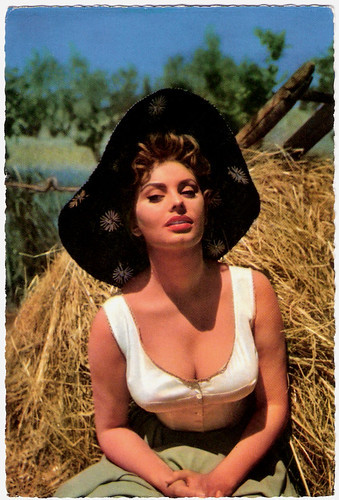
German postcard by UFA, no. 1007. Photo: UFA. Publicity still for La bella mugnaia/The Miller's Wife (Mario Camerini, 1955).
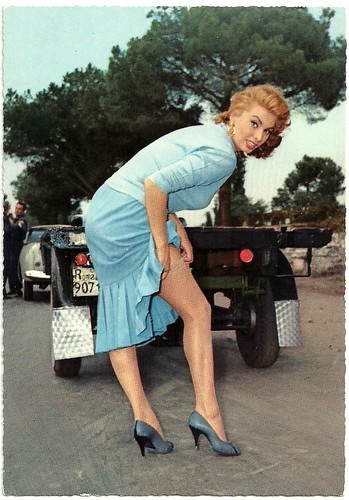
German postcard by UFA. Photo: publicity still for La fortuna di essere donna/What a Woman! (Alessandro Blasetti, 1956).
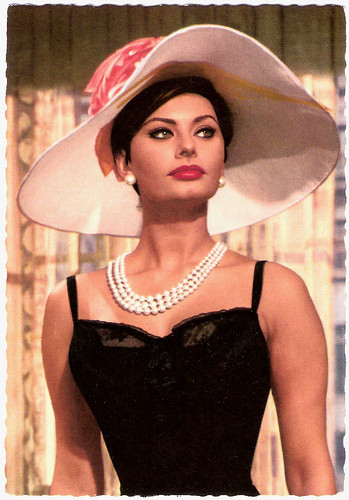
German postcard by Filmbilder-Vertrieb Ernst Freihoff, Essen, no. A 102. Photo: 20th Century Fox. Publicity still for The Millionairess (Anthony Asquith, 1960).
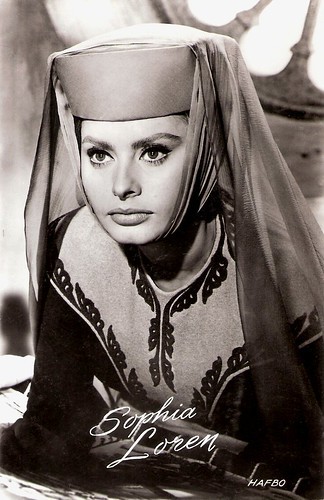
Dutch postcard by Uitg. Takken, Utrecht, no. 4894. Photo: Hafbo. Publicity still from El Cid (Anthony Mann, 1961).
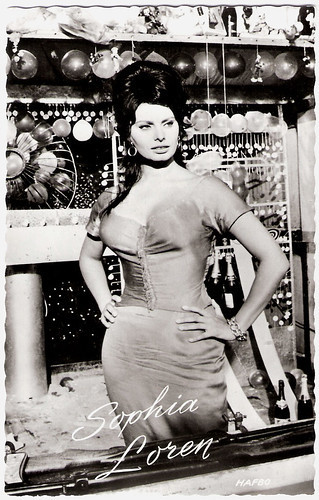
German postcard by Filmbilder-Vertrieb Ernst Freihoff, EssenParis, no. 5096. Photo: publicity still for Boccaccio '70 (Vittorio De Sica, 1962).
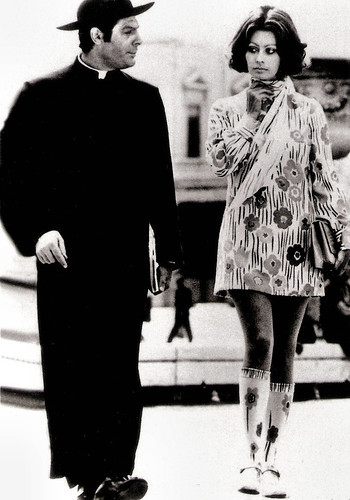
German postcard by pwe Verlag, München (Munich). Photo: publicity still for La moglie del prete/The Priest's Wife (Dino Risi, 1970) with Marcello Mastroianni .
In 'Ieri, oggi, domani', the then nearly 80 years old Sophia Loren waits for her grandchildren while preparing a Christmas dinner for her family. She opens a box full of little objects, which bring back memories of a long life and a magnificent career. The title of this memoir, which translates as 'Yesterday, today, tomorrow', refers to her famous film from 1963 in which she costarred with Marcello Mastroianni and was directed by Vittorio De Sica. In her book, she often refers to these two friends, who were as important for her career as she was for theirs. Less she writes about what her husband, producer Carlo Ponti, meant for her film career.

Dutch book cover for Sophia Loren, 'Mijn leven - Ieri, oggi, domani' (1994). Original title: 'Ieri, oggi, domani'. Translated by Edwin Krijgsman and Els van der Pluijm. Publisher: Uitgeverij-Sijthoff B.V., Amsterdam.
That famous sensual walk through the rain
The most interesting part of Sophia Loren 's film career was in the Italian cinema. During the 1950s and 1960s, she was a typical film producer's muse. Like Silvana Mangano often worked with husband Dino De Laurentiis and Claudia Cardinale with her husband Franco Cristaldi, Sophia almost always worked with Carlo Ponti.
In 1951, the 17-year old Sofia Scicolone met Ponti, then 39 and married. Ponti was a great catch. In 1941, he had had his breakthrough as a producer with the drama Piccolo mondo antico/Old-Fashioned World (Mario Soldati, 1941), which made a star of Alida Valli . In 1949 Ponti started his own production company together with Dino De Laurentiis. They worked with all the major directors of the time: De Sica, Lattuada, Rossellini, Blasetti, Visconti... Sophia wonders in retrospect if she realised how important her new companion was.
In 1949, Sofia started her career at a beauty contest in a cinema in Naples, to which she was pushed by her poor mammina. She won a prize which included a train ticket to Rome. In her memoir, Loren vividly describes how she and her mother arrived in Cinecittà, where MGM was just filming Quo Vadis?. Rome had become Hollywood on the Tiber! Director Mervyn Le Roy even offered Sofia a bit part in the film, although the only English word she could say to him was 'yes'.
In the following years, she gathered experience by posing for the very popular Fotoromanzi, the photo comics which emerged in Italy in the 1940s and expanded into the 1950s. Loren writes that the Fotoromanzo, introduced by the De Luca brothers and the Milanese company Universo, helped her to learn to express herself. For her and other young hopefuls, they formed a stepping stone to the cinema.
Was it Carlo who helped her get her first leading role in Africa sotto i mari/Africa Under the Seas (Giovanni Roccardi, 1953)? Probably, but Loren had real star appeal. In the publicity stills of her first films, she already looked sensational. A beauty with a natural talent who enjoyed Cinecittà as her wonderland.
Loren did one film after another in these years. And then came her 28th film (in four years), she was directed by Vittorio De Sica in Pizze a credito, a segment of the anthology film L'oro di Napoli (Vittorio De Sica, 1954). She played a charming Neapolitan pizza cook, who loses an emerald ring which her husband gave her. She searches for it and supposes she baked it into a pizza, but in reality she left it on her lover's nightstand. Her vivacious smile, her pronounced cleavage and her famous sensual walk through the rain while followed by her cuckolded husband made her an international star. It started a long series of films with De Sica, and soon also Hollywood was calling.

German postcard printed by Krüger, no. 902/304. Photo: Georg Michalke. Publicity still for Loren's 31nd (!) Italian film, La donna del fiume/Woman of the River (Mario Soldati, 1954).

Italian postcard by Rotalfoto, Milano, no. 328. Photo: Ponti-De Laurentiis. Publicity still for La donna del fiume/Woman of the River (Mario Soldati, 1954).

Italian postcard by Rotalfoto, Milano, no. 358.

Italian postcard by Rotalfoto, Milano, no. 449. Photo: Documento Film. Publicity still for Peccato che sia una canaglia/Too Bad She's Bad (Alessandro Blasetti, 1954).

Italian postcard by Rotalfoto, Milano, no. 591.
A tough cookie from Naples
Sophia Loren writes about her encounters and films in Hollywood, but she remains a lady who does not gossip. She writes warmly about admirers as Cary Grant and Peter Sellers .
One of the few co-stars, whom she did not like was Marlon Brando , her co-star in A Countess from Hong Kong (Charles Chaplin, 1967). She describes how Brando arrives three quarters too late at the first day of shooting, how the whole crew has to wait and how Chaplin scolds him in front of the whole crew. From then on, Brando never arrived late again at the set.
Later during the production of the film, Brando made a pass at her. Loren reacted as a blazing cat and furiously hissed "Don't ever do that again! Never, never again." No, for Ms. Loren #metoo was not necessary, growing up poor in a little village near Naples had made her a tough cookie.
La Loren writes a lot about her family, her passion for cooking and her troubles with the Italian government concerning the divorce of Carlo Ponti and his first wife and concerning taxes. She even had to go 100 days to jail for that, although the state later offcially declared that she was innocent.
It's all interesting, but I like the book most when Loren tells about her films. About her first 'serious' role in La Ciociara/Two Women (Vittorio De Sica, 1961), for which she won an Oscar, and of course for Una giornata particolare/A Special Day (Ettore Scola, 1977). Once again she surprised critics and filmgoers by playing a resigned housewife in Fascist Italy, who expresses a whole range of feelings in just one look.
Una giornata particolare was for me her pne of her best pairings with co-star Marcello Mastroianni . He plays her neighbour, a persecuted, homosexual journalist, who is just as lonely as she is. During a national holiday when Hitler visits Rome in May 1938 and everybody is out on the streets to see the parade, the two have a brief encounter on the roof of their apartment complex. An unforgettable love story between two people who don't fit in the world they live in.

French postcard by P.I. / Korès, no. 38. Photo: Constantin Film. Publicity still for La bella mugnaia/The Miller's Wife (Mario Camerini, 1955).

German postcard by UFA, no. 1007. Photo: UFA. Publicity still for La bella mugnaia/The Miller's Wife (Mario Camerini, 1955).

German postcard by UFA. Photo: publicity still for La fortuna di essere donna/What a Woman! (Alessandro Blasetti, 1956).

German postcard by Filmbilder-Vertrieb Ernst Freihoff, Essen, no. A 102. Photo: 20th Century Fox. Publicity still for The Millionairess (Anthony Asquith, 1960).

Dutch postcard by Uitg. Takken, Utrecht, no. 4894. Photo: Hafbo. Publicity still from El Cid (Anthony Mann, 1961).

German postcard by Filmbilder-Vertrieb Ernst Freihoff, EssenParis, no. 5096. Photo: publicity still for Boccaccio '70 (Vittorio De Sica, 1962).

German postcard by pwe Verlag, München (Munich). Photo: publicity still for La moglie del prete/The Priest's Wife (Dino Risi, 1970) with Marcello Mastroianni .
Published on July 17, 2019 22:00
July 16, 2019
Rolf Wanka
Austrian actor Rolf Wanka (1901-1982) was a handsome, suave star of the European cinema of the 1930s and the 1950s. He often played supporting parts as well-dressed, dignified gentlemen, and appeared in more than 100 films and television shows between 1931 and 1976.

German postcard by Ross Verlag, no. 9844/1, 1935-1936. Photo: Metropolitan-Film.

German postcard by Das Programm von Heute, Berlin. Photo: Bild u. Ton.

German postcard by Ufa/Film-Foto, Berlin-Tempelhof, no. FK 1228. Photo: Rolf Lantin.
The Lover of Love
Rudolf Josef Wanka was born in 1901 in Vienna, Austria-Hungary (now Austria).
He studied at the Technological Highschool in Prague, and later at the universities of Innsbruck and Vienna, where he majored in economics, medicine and philosophy. From 1928 on, he was the director of a machine factory.
In 1931, he made his film debut with a bit part in the classic thriller M - Eine Stadt sucht einen Mörder/M (Fritz Lang, 1931), starring Peter Lorre . The film revolves around the actions of a serial killer of children and the manhunt for him, conducted by both the police and the criminal underworld.
Wanka decided to become an actor The following year, he appeared in the German-Czech comedy Wehe, wenn er losgelassen/Woe, if he let go (Martin Fric, Karel Lamac, 1932). In 1933 and 1934, he studied acting with Aurel Novotny in Vienna.
In the next years he took part in German, Austrian as well as in Czech films. In 1935, he was the partner of Marta Eggerth in the comedy Die ganze Welt dreht sich um Liebe/The World's in Love (Viktor Tourjansky, 1935).
He played leading roles in in such films as the drama Páter Vojtech/Father Vojtech (Martin Fric, 1936), the musical Flucht an die Adria/Escape to the Adriatic (Eugen Schulz-Breiden, 1937) and the romantic comedy Poslícek lásky/The Lover of Love (Miroslav Cikán, 1937) with Hana Vitova. These films were shot at the Barrandov Studios in Prague, and they were often made in alternate language versions in German and Czech.
Rolf Wanka also directed one film, Vydelecne zeny/Working Woman (Rolf Wanka, 1937).

German postcard by Das Programm von Heute, Berlin. Photo: Metropolitan / Bavaria. Publicity still for Rote Rosen - blaue Adria/Red Roses - Blue Adriatic (Jan Sviták, 1938).

German postcard by Ross Verlag, no. 9914/1, 1935-1936. Photo: Panorama / Märkische / Schneider.
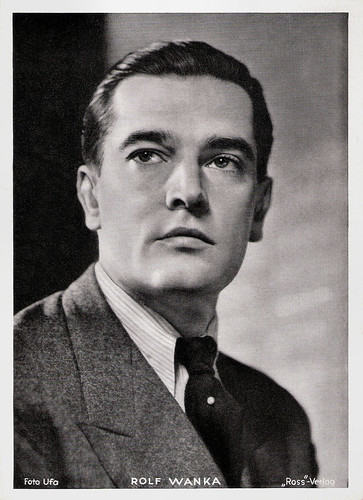
Big German card by Ross Verlag. Photo: Ufa.
Captain Sindbad
Rolf Wanka was multi-lingual and for his role in the French adventure film Alerte en Méditerranée/Alert in the Mediterranean (Leo Joannon, 1938) with Pierre Fresnay , he was awarded the Grand prix du cinéma français.
After the outbreak of the Second World War, he limited his film work. He first accepted a commitment to the Vienna Kammerspiele and was artistic director of the Vienna City Theater from 1940 to 1944. After the war, he appeared mainly at the Raimundtheater and at the Theater in der Josefstadt in Vienna.
During the 1950s, he returned to the cinema and played in German and Austrian productions as well as in several Spanish films. These included La mestiza (José María Ochoa, 1956) with Lida Baarova , El batallón de las sombras/The Battalion of Shadows (Manuel Mur Oti, 1957) and Horas de pánico/Day of Fear (Donald Taylor, 1957). In 1963, he appeared as the King in the American-German adventure film Captain Sindbad (Byron Haskin, 1963) featuring Guy Williams.
He made his last screen appearances during the 1970s. His last film was the excellent historical war drama Il deserto dei tartari/The Desert of the Tartars (Valerio Zurlini, 1976), starring Jacques Perrin and Vittorio Gassman . On TV, his final appearance was in an episode of the Krimi series Tatort (1978).
Rolf Wanka died in 1982 in Munich, West Germany. He was married to Ilse Vogl and actress Friedl Czepa. From a liaison with Helene Amon his son Rudolf Wanka was born in 1954, whom he adopted at the age of 4 years. In 1954, he met Brigitta Dahlem, who became his third wife, known as Lili Wanka. In 1961, their daughter, actress Irina Wanka, was born.
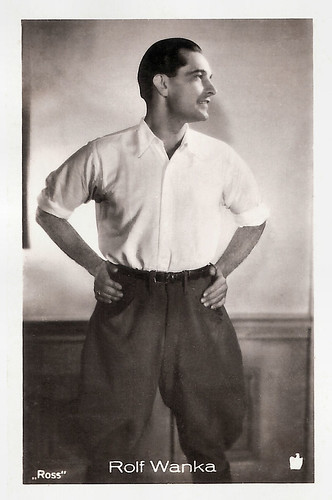
Small German collectors card by Ross Verlag.

German postcard by Ross Verlag, no. A 2569/1, 1939-1940. Photo: Cine Allianz.

German postcard by Franz Josef Rüdel, Filmpostkartenverlag, Hamburg. Photo: Ferdy Dittmar, Stuttgart.
Sources: Wikipedia (English and German), and .

German postcard by Ross Verlag, no. 9844/1, 1935-1936. Photo: Metropolitan-Film.

German postcard by Das Programm von Heute, Berlin. Photo: Bild u. Ton.

German postcard by Ufa/Film-Foto, Berlin-Tempelhof, no. FK 1228. Photo: Rolf Lantin.
The Lover of Love
Rudolf Josef Wanka was born in 1901 in Vienna, Austria-Hungary (now Austria).
He studied at the Technological Highschool in Prague, and later at the universities of Innsbruck and Vienna, where he majored in economics, medicine and philosophy. From 1928 on, he was the director of a machine factory.
In 1931, he made his film debut with a bit part in the classic thriller M - Eine Stadt sucht einen Mörder/M (Fritz Lang, 1931), starring Peter Lorre . The film revolves around the actions of a serial killer of children and the manhunt for him, conducted by both the police and the criminal underworld.
Wanka decided to become an actor The following year, he appeared in the German-Czech comedy Wehe, wenn er losgelassen/Woe, if he let go (Martin Fric, Karel Lamac, 1932). In 1933 and 1934, he studied acting with Aurel Novotny in Vienna.
In the next years he took part in German, Austrian as well as in Czech films. In 1935, he was the partner of Marta Eggerth in the comedy Die ganze Welt dreht sich um Liebe/The World's in Love (Viktor Tourjansky, 1935).
He played leading roles in in such films as the drama Páter Vojtech/Father Vojtech (Martin Fric, 1936), the musical Flucht an die Adria/Escape to the Adriatic (Eugen Schulz-Breiden, 1937) and the romantic comedy Poslícek lásky/The Lover of Love (Miroslav Cikán, 1937) with Hana Vitova. These films were shot at the Barrandov Studios in Prague, and they were often made in alternate language versions in German and Czech.
Rolf Wanka also directed one film, Vydelecne zeny/Working Woman (Rolf Wanka, 1937).

German postcard by Das Programm von Heute, Berlin. Photo: Metropolitan / Bavaria. Publicity still for Rote Rosen - blaue Adria/Red Roses - Blue Adriatic (Jan Sviták, 1938).

German postcard by Ross Verlag, no. 9914/1, 1935-1936. Photo: Panorama / Märkische / Schneider.

Big German card by Ross Verlag. Photo: Ufa.
Captain Sindbad
Rolf Wanka was multi-lingual and for his role in the French adventure film Alerte en Méditerranée/Alert in the Mediterranean (Leo Joannon, 1938) with Pierre Fresnay , he was awarded the Grand prix du cinéma français.
After the outbreak of the Second World War, he limited his film work. He first accepted a commitment to the Vienna Kammerspiele and was artistic director of the Vienna City Theater from 1940 to 1944. After the war, he appeared mainly at the Raimundtheater and at the Theater in der Josefstadt in Vienna.
During the 1950s, he returned to the cinema and played in German and Austrian productions as well as in several Spanish films. These included La mestiza (José María Ochoa, 1956) with Lida Baarova , El batallón de las sombras/The Battalion of Shadows (Manuel Mur Oti, 1957) and Horas de pánico/Day of Fear (Donald Taylor, 1957). In 1963, he appeared as the King in the American-German adventure film Captain Sindbad (Byron Haskin, 1963) featuring Guy Williams.
He made his last screen appearances during the 1970s. His last film was the excellent historical war drama Il deserto dei tartari/The Desert of the Tartars (Valerio Zurlini, 1976), starring Jacques Perrin and Vittorio Gassman . On TV, his final appearance was in an episode of the Krimi series Tatort (1978).
Rolf Wanka died in 1982 in Munich, West Germany. He was married to Ilse Vogl and actress Friedl Czepa. From a liaison with Helene Amon his son Rudolf Wanka was born in 1954, whom he adopted at the age of 4 years. In 1954, he met Brigitta Dahlem, who became his third wife, known as Lili Wanka. In 1961, their daughter, actress Irina Wanka, was born.

Small German collectors card by Ross Verlag.

German postcard by Ross Verlag, no. A 2569/1, 1939-1940. Photo: Cine Allianz.

German postcard by Franz Josef Rüdel, Filmpostkartenverlag, Hamburg. Photo: Ferdy Dittmar, Stuttgart.
Sources: Wikipedia (English and German), and .
Published on July 16, 2019 22:00
July 15, 2019
I.N.R.I. (1923)
The German silent film I.N.R.I. (1923), directed by Robert Wiene, was one of the first big-screen adaptations of the Passion of Christ. The film retells the events leading up to the crucifixion of Jesus. The Ukrainian born actor Gregori Chmara played Jesus Christ, Henny Porten the Virgin Mary and Alexander Granach Judas. Asta Nielsen also appeared as Maria Magdalen.
I.N.R.I.
was reissued in 1933 in the United States with an added music track and narration as Crown of Thorns.
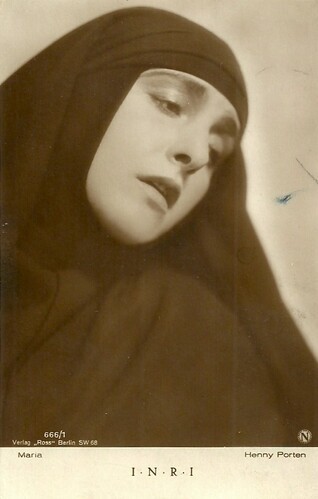
German postcard by Ross Verlag, no. 666/1. Photo: Neumann. Henny Porten as Mary in I.N.R.I. (Robert Wiene, 1923).
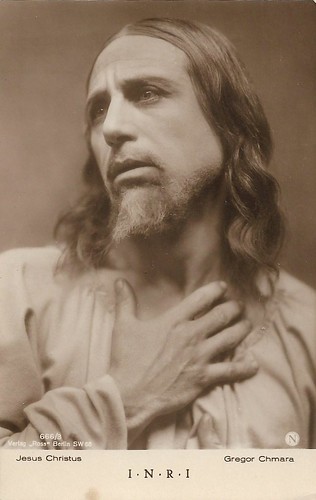
German postcard by Ross Verlag, no. 666/3. Photo: Neumann. Gregori Chmara as Jesus Christ in I.N.R.I. (Robert Wiene, 1923).
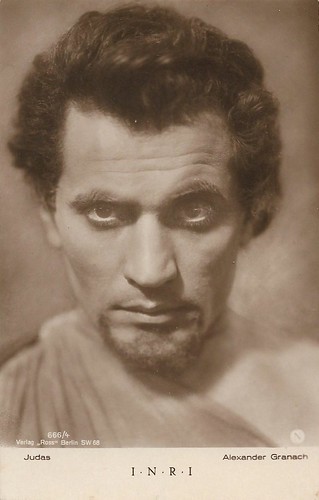
German postcard by Ross Verlag, Berlin, no. 666/4. Photo: Neumann. Alexander Granach as Judas in I.N.R.I. (Robert Wiene, 1923).
Judas as a social revolutionary
I.N.R.I. (1923) was made by Robert Wiene, who had revolutionised the German cinema with his expressionist film Das Cabinet des Dr. Caligari/The Cabinet of Dr. Caligari (1920). He just had made Raskolnikow/Crime and Punishment (1923), also starring Gregori Chmara and the Moscow Art Theatre players.
Wiene had based I.N.R.I. on a 1905 novel by Peter Rosegger and he embedded the Passion of Christ in a contemporary story. The film is generally conventional in its treatment of the story except for the character of Judas Iscariot (Alexander Granach).
Wiene portrays Judas as a social revolutionary who wants Jesus ( Gregori Chmara ) to become the leader of a Jewish uprising against the Roman army of occupation. Judas' eventual betrayal of Jesus comes from political disillusionment rather than money. The Judas role is very important to the film as it was conceived by Wiene, because it links the biblical story to the framing story.
The framing story is set in modern Russia. An anarchist shoots the prime minister of his country out of political conviction. He is sentenced to death. A few hours before the execution, he starts doubting the meaning of his death and he decides to write down the Passion of Christ.
It is believed that Wiene intended the framing story to give the Biblical story an anti-Bolshevist propaganda function. However, the modern scenes provoked opposition from the censors, and the film was generally shown without them
IMDb suggests it was added without the knowledge of the actors in the Passion story, who included some of the major stars of the period: Asta Nielsen as the seductive Mary Magdalene, Henny Porten as Jesus' mother Mary, and Werner Krauss as Pontius Pilate. Krauss played the titular Dr Caligari in Wiene's famous film.
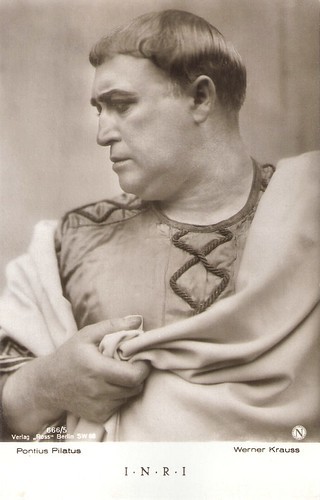
German postcard by Ross Verlag , Berlin, no. 666/5, 1919-1924. Photo: Neumann. Werner Krauss as Pontius Pilate in I.N.R.I. (Robert Wiene, 1923).
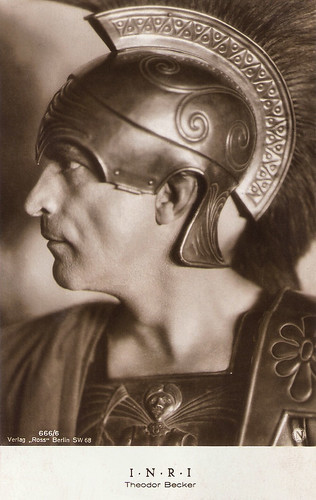
German postcard by Ross Verlag, Berlin, no. 666/6. Photo: Neumann. Theodor Becker as the Roman captain in I.N.R.I./Crown of Thorns (Robert Wiene, 1923).
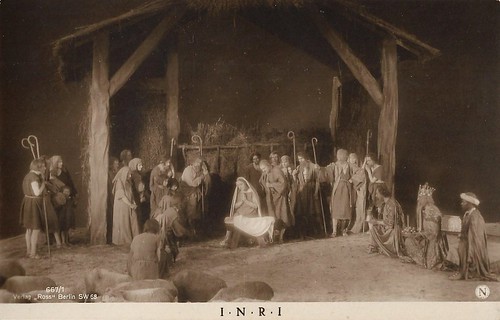
German postcard by Ross Verlag, Berlin, no. 667/1. Photo: Neumann. The Nativity Scene with Henny Porten as Mary in I.N.R.I. (Robert Wiene, 1923).
Expensive sets and hundreds of extras
I.N.R.I. (Robert Wiene, 1923) was shot over 90 days between May and September 1923 at the Staaken Studios in Berlin. The film was produced by Hans Neumann and Hans von Wolzogen for Neumann-Filmproduktion
I.N.R.I. was the first biblical epic made in Germany and it was made with expensive sets and hundreds of extras for the mass scenes. In scale and length, it was the largest film directed by Robert Wiene during his career. He had Ernö Metzner for the film's art direction and had three cinematographers to film his epic: Axel Graatkjær, Reimar Kuntze and Ludwig Lippert.
Edgar Mauricio, at his blog Stone Movie Spree, is impressed: "As for the staging, the work done by the expressionist master is impeccable, his setting is impeccable, the costumes, the decorations, without excessive ornaments or mannerisms, but a simplicity that leads to a more intimate closeness to what is portrayed, and it contrasts with the reloading efforts of representation that can be seen in these days, so artificial and pastiche that they end up eliminating a genuine approach to those days.
I.N.R.I. premiered in Berlin on Christmas Day 1925. The film received mixed reviews in the German newspapers and soon disappeared from the cinema screens.
For a long time I.N.R.I. was believed to be lost, but a surviving complete copy, a 16mm print, was discovered in the archives of the Cineteca del Friuli in Italy in October 1999. Since the film lacked opening credits, it had been labelled as an unknown film. Another copy was found in Japan and screened at National Film Center, Tokyo at February 2006. Although it looks like some scenes are missing, it is 35mm tinted print with English intertitles.
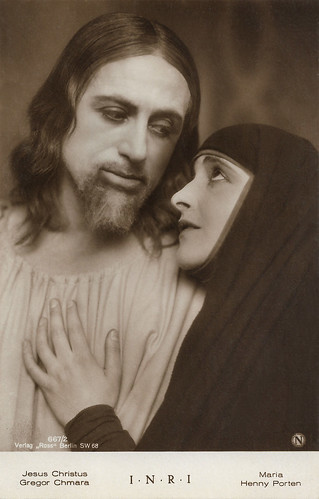
German postcard by Ross Verlag, Berlin, no. 667/2. Photo: Neumann. Gregori Chmara as Jesus Christ and Henny Porten as Mary in I.N.R.I. (Robert Wiene, 1923).
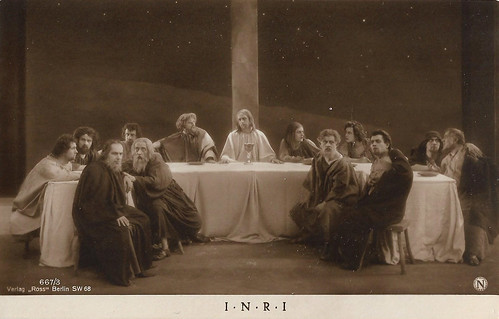
German postcard by Ross Verlag, Berlin, no. 667/3. Photo: Neumann. Gregori Chmara as Jesus Christ at the Last Supper in I.N.R.I. (Robert Wiene, 1923). Foreground right, looking up is Alexander Granach as Judas.
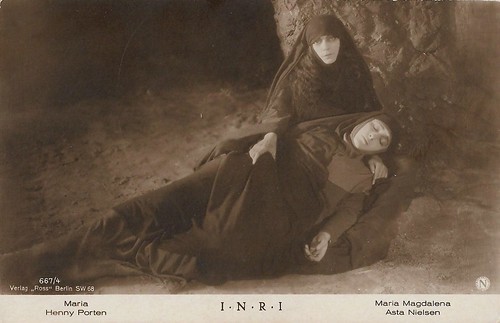
German postcard by Ross Verlag, Berlin, no. 667/4. Photo: Neumann. Asta Nielsen as Mary Magdalen and Henny Porten as the Virgin Mary in I.N.R.I. (Robert Wiene, 1923).
Sources: Edgar Mauricio (Stone Movies Spree), Ed Meza (Variety), Wikipedia and IMDb.

German postcard by Ross Verlag, no. 666/1. Photo: Neumann. Henny Porten as Mary in I.N.R.I. (Robert Wiene, 1923).

German postcard by Ross Verlag, no. 666/3. Photo: Neumann. Gregori Chmara as Jesus Christ in I.N.R.I. (Robert Wiene, 1923).

German postcard by Ross Verlag, Berlin, no. 666/4. Photo: Neumann. Alexander Granach as Judas in I.N.R.I. (Robert Wiene, 1923).
Judas as a social revolutionary
I.N.R.I. (1923) was made by Robert Wiene, who had revolutionised the German cinema with his expressionist film Das Cabinet des Dr. Caligari/The Cabinet of Dr. Caligari (1920). He just had made Raskolnikow/Crime and Punishment (1923), also starring Gregori Chmara and the Moscow Art Theatre players.
Wiene had based I.N.R.I. on a 1905 novel by Peter Rosegger and he embedded the Passion of Christ in a contemporary story. The film is generally conventional in its treatment of the story except for the character of Judas Iscariot (Alexander Granach).
Wiene portrays Judas as a social revolutionary who wants Jesus ( Gregori Chmara ) to become the leader of a Jewish uprising against the Roman army of occupation. Judas' eventual betrayal of Jesus comes from political disillusionment rather than money. The Judas role is very important to the film as it was conceived by Wiene, because it links the biblical story to the framing story.
The framing story is set in modern Russia. An anarchist shoots the prime minister of his country out of political conviction. He is sentenced to death. A few hours before the execution, he starts doubting the meaning of his death and he decides to write down the Passion of Christ.
It is believed that Wiene intended the framing story to give the Biblical story an anti-Bolshevist propaganda function. However, the modern scenes provoked opposition from the censors, and the film was generally shown without them
IMDb suggests it was added without the knowledge of the actors in the Passion story, who included some of the major stars of the period: Asta Nielsen as the seductive Mary Magdalene, Henny Porten as Jesus' mother Mary, and Werner Krauss as Pontius Pilate. Krauss played the titular Dr Caligari in Wiene's famous film.

German postcard by Ross Verlag , Berlin, no. 666/5, 1919-1924. Photo: Neumann. Werner Krauss as Pontius Pilate in I.N.R.I. (Robert Wiene, 1923).

German postcard by Ross Verlag, Berlin, no. 666/6. Photo: Neumann. Theodor Becker as the Roman captain in I.N.R.I./Crown of Thorns (Robert Wiene, 1923).

German postcard by Ross Verlag, Berlin, no. 667/1. Photo: Neumann. The Nativity Scene with Henny Porten as Mary in I.N.R.I. (Robert Wiene, 1923).
Expensive sets and hundreds of extras
I.N.R.I. (Robert Wiene, 1923) was shot over 90 days between May and September 1923 at the Staaken Studios in Berlin. The film was produced by Hans Neumann and Hans von Wolzogen for Neumann-Filmproduktion
I.N.R.I. was the first biblical epic made in Germany and it was made with expensive sets and hundreds of extras for the mass scenes. In scale and length, it was the largest film directed by Robert Wiene during his career. He had Ernö Metzner for the film's art direction and had three cinematographers to film his epic: Axel Graatkjær, Reimar Kuntze and Ludwig Lippert.
Edgar Mauricio, at his blog Stone Movie Spree, is impressed: "As for the staging, the work done by the expressionist master is impeccable, his setting is impeccable, the costumes, the decorations, without excessive ornaments or mannerisms, but a simplicity that leads to a more intimate closeness to what is portrayed, and it contrasts with the reloading efforts of representation that can be seen in these days, so artificial and pastiche that they end up eliminating a genuine approach to those days.
I.N.R.I. premiered in Berlin on Christmas Day 1925. The film received mixed reviews in the German newspapers and soon disappeared from the cinema screens.
For a long time I.N.R.I. was believed to be lost, but a surviving complete copy, a 16mm print, was discovered in the archives of the Cineteca del Friuli in Italy in October 1999. Since the film lacked opening credits, it had been labelled as an unknown film. Another copy was found in Japan and screened at National Film Center, Tokyo at February 2006. Although it looks like some scenes are missing, it is 35mm tinted print with English intertitles.

German postcard by Ross Verlag, Berlin, no. 667/2. Photo: Neumann. Gregori Chmara as Jesus Christ and Henny Porten as Mary in I.N.R.I. (Robert Wiene, 1923).

German postcard by Ross Verlag, Berlin, no. 667/3. Photo: Neumann. Gregori Chmara as Jesus Christ at the Last Supper in I.N.R.I. (Robert Wiene, 1923). Foreground right, looking up is Alexander Granach as Judas.

German postcard by Ross Verlag, Berlin, no. 667/4. Photo: Neumann. Asta Nielsen as Mary Magdalen and Henny Porten as the Virgin Mary in I.N.R.I. (Robert Wiene, 1923).
Sources: Edgar Mauricio (Stone Movies Spree), Ed Meza (Variety), Wikipedia and IMDb.
Published on July 15, 2019 22:00
July 14, 2019
Barbara Lang
Beautiful, brassy Barbara Lang (1928–1982) was an American actress and singer. During the 1950s she was one of the many B-level blondes in Hollywood who were promoted as the new Marilyn Monroe. However, Lang appeared in only three films.

German postcard by ISV, Sort V 6.

Italian postcard by Casa Editr. Ballerini & Fratini, Firenze (B.F.F. Edit.), no. 3480. Photo: Metro-Goldwyn-Mayer. Collection: Marlene Pilaete.
Faith performing a miracle
Barbara Lang was born as Barbara Jean Bly in 1928 in Hollywood, California, U.S. She was the daughter of Los Angeles nose drop bottler Leonidis Stannage Bly and his wife Esther W., nee Kaufman, former silent movie dancer Maureen Knight.
Barbara worked a number of jobs before she broke into the entertainment industry. She sold jewellery in a Los Angeles department store and was a part-time fashion model at the age of seventeen. She was also a pianist and singer for a time in a cocktail lounge.
Lang suffered an attack of poliomyelitis in late 1953. She spent three weeks in the polio ward of Los Angeles General Hospital. Lang was told that she might never walk again. She turned to the Bible during this time and reportedly credited faith for performing a miracle. Shortly after being stricken, her legs and facial muscles were paralysed, and she had difficulty speaking. After many months of treatment she was able to walk again. The lingering effects of her illness robbed her of much of her stamina and she would tire easily for the rest of her life.
Recovered from polio, Lang went into television work. She first came to the attention of Hollywood producers with appearances in Death Valley Days (1955–1956), a TV series featuring true stories of the old American West, particularly the Death Valley area. Reportedly, half a dozen film studios vied to sign Lang after her TV performances.
She chose for Metro Goldwyn Mayer and was assigned to drama lessons. The starlet's first role was a bit part in Hot Summer Night (David Friedkin, 1957), starring Leslie Nielsen.
As a new star for MGM, Lang played the feminine lead in the Film Noir House of Numbers (Russell Rouse, 1957), co-starring with Jack Palance. In the film, Palance plays two similar-looking brothers: Bill and his younger brother Arnie Judlow. Bill is a good citizen, trying to help his ex-professional boxer brother, Arnie, convicted of murder, escape from San Quentin State Prison to return to Arnie's wife, Ruth, played by Lang. It was filmed inside San Quentin Prison and in Mill Valley, California.
Bethany Cox at IMDb : “While the story is less than perfect, there are some twists that keep it from being a standard thriller and there is some low-key suspense. The prison escape scheme is at times pretty ingenious. The characters maintain interest and the chemistry between the actors is continually good.”

German postcard by ISV, B 11. Photo: MGM. Still for House of Numbers (Russell Rouse, 1957).
A Chicago showgirl of the 1930s called Ginger D'Amour
In the classy, exciting Film Noir Party Girl (Nicholas Ray, 1958), Barbara Lang played the supporting part of Ginger D'Amour, a Chicago showgirl of the 1930s.
Bruce Eder at AllMovie : “Party Girl is regarded by many Nicholas Ray fans as the most beautiful looking of all of his movies. Shot in CinemaScope and color, and starring Cyd Charisse (with Robert Taylor, it gave cinematographer Robert J. Bronner one of the best showcases he ever had for his work, and was a treat to the eye of the viewer, a veritable explosion of color and motion for many of its best sequences.”
A huge disappointment then for Barbara was when she lost out on the co-starring role opposite Elvis Presley in Jailhouse Rock (Richard Thorpe, 1957). After being initially named by the studio for the part, Judy Tyler was given the coveted role instead.
Lang would make only three films, but her TV credits are numerous. She appeared in episodes of The Thin Man (1957), Maverick (1958), The Bob Cummings Show (1958), 77 Sunset Strip (1959), Lawman (1959), Tightrope (1959), and The Outlaws (1960).
In November 1958, Lang won an annulment of her two-year marriage to actor Alan Wells, who had been her co-star in Death Valley Days. The decree was granted on grounds that Wells married Lang in Ensenada, Mexico, ten months before his divorce from actress Claudia Barrett was final.
Gary Brumburgh at IMDb : “With her annulment from Wells finalised in 1958 and a career going into an abrupt tailspin, Barbara attempted suicide in 1959 with an overdose of sleeping pills. She recovered but her career did not.”
Wells was her second husband. The first had been William McCorkle (1946-1952; divorced), and her final husband would be John George (1967-1972; divorced). She had two daughters, Pam and Cheryl. At age 54, Barbara Lang died in 1982 in Los Angeles, reportedly from pneumonia.
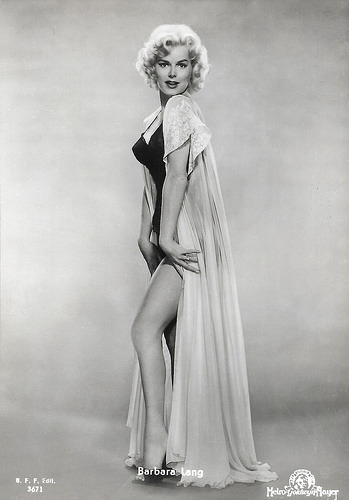
Italian postcard by Casa Editr. Ballerini & Fratini, Firenze, no. 3671. Photo: MGM. Publicity still for House of Numbers (Russell Rouse, 1957).
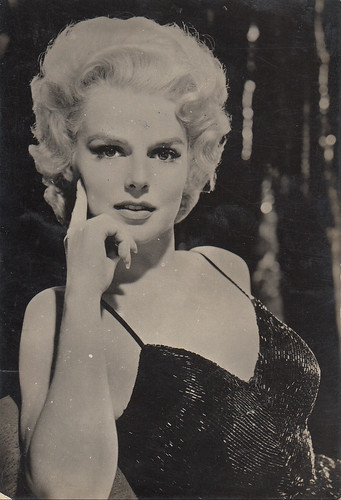
Spanish postcard, no. 2823. Collection: Marlene Pilaete.
Sources: Bruce Eder (AllMovie), (IMDb), Glamour Girls of the Silver Screen, AllMovie, Wikipedia, and .

German postcard by ISV, Sort V 6.

Italian postcard by Casa Editr. Ballerini & Fratini, Firenze (B.F.F. Edit.), no. 3480. Photo: Metro-Goldwyn-Mayer. Collection: Marlene Pilaete.
Faith performing a miracle
Barbara Lang was born as Barbara Jean Bly in 1928 in Hollywood, California, U.S. She was the daughter of Los Angeles nose drop bottler Leonidis Stannage Bly and his wife Esther W., nee Kaufman, former silent movie dancer Maureen Knight.
Barbara worked a number of jobs before she broke into the entertainment industry. She sold jewellery in a Los Angeles department store and was a part-time fashion model at the age of seventeen. She was also a pianist and singer for a time in a cocktail lounge.
Lang suffered an attack of poliomyelitis in late 1953. She spent three weeks in the polio ward of Los Angeles General Hospital. Lang was told that she might never walk again. She turned to the Bible during this time and reportedly credited faith for performing a miracle. Shortly after being stricken, her legs and facial muscles were paralysed, and she had difficulty speaking. After many months of treatment she was able to walk again. The lingering effects of her illness robbed her of much of her stamina and she would tire easily for the rest of her life.
Recovered from polio, Lang went into television work. She first came to the attention of Hollywood producers with appearances in Death Valley Days (1955–1956), a TV series featuring true stories of the old American West, particularly the Death Valley area. Reportedly, half a dozen film studios vied to sign Lang after her TV performances.
She chose for Metro Goldwyn Mayer and was assigned to drama lessons. The starlet's first role was a bit part in Hot Summer Night (David Friedkin, 1957), starring Leslie Nielsen.
As a new star for MGM, Lang played the feminine lead in the Film Noir House of Numbers (Russell Rouse, 1957), co-starring with Jack Palance. In the film, Palance plays two similar-looking brothers: Bill and his younger brother Arnie Judlow. Bill is a good citizen, trying to help his ex-professional boxer brother, Arnie, convicted of murder, escape from San Quentin State Prison to return to Arnie's wife, Ruth, played by Lang. It was filmed inside San Quentin Prison and in Mill Valley, California.
Bethany Cox at IMDb : “While the story is less than perfect, there are some twists that keep it from being a standard thriller and there is some low-key suspense. The prison escape scheme is at times pretty ingenious. The characters maintain interest and the chemistry between the actors is continually good.”

German postcard by ISV, B 11. Photo: MGM. Still for House of Numbers (Russell Rouse, 1957).
A Chicago showgirl of the 1930s called Ginger D'Amour
In the classy, exciting Film Noir Party Girl (Nicholas Ray, 1958), Barbara Lang played the supporting part of Ginger D'Amour, a Chicago showgirl of the 1930s.
Bruce Eder at AllMovie : “Party Girl is regarded by many Nicholas Ray fans as the most beautiful looking of all of his movies. Shot in CinemaScope and color, and starring Cyd Charisse (with Robert Taylor, it gave cinematographer Robert J. Bronner one of the best showcases he ever had for his work, and was a treat to the eye of the viewer, a veritable explosion of color and motion for many of its best sequences.”
A huge disappointment then for Barbara was when she lost out on the co-starring role opposite Elvis Presley in Jailhouse Rock (Richard Thorpe, 1957). After being initially named by the studio for the part, Judy Tyler was given the coveted role instead.
Lang would make only three films, but her TV credits are numerous. She appeared in episodes of The Thin Man (1957), Maverick (1958), The Bob Cummings Show (1958), 77 Sunset Strip (1959), Lawman (1959), Tightrope (1959), and The Outlaws (1960).
In November 1958, Lang won an annulment of her two-year marriage to actor Alan Wells, who had been her co-star in Death Valley Days. The decree was granted on grounds that Wells married Lang in Ensenada, Mexico, ten months before his divorce from actress Claudia Barrett was final.
Gary Brumburgh at IMDb : “With her annulment from Wells finalised in 1958 and a career going into an abrupt tailspin, Barbara attempted suicide in 1959 with an overdose of sleeping pills. She recovered but her career did not.”
Wells was her second husband. The first had been William McCorkle (1946-1952; divorced), and her final husband would be John George (1967-1972; divorced). She had two daughters, Pam and Cheryl. At age 54, Barbara Lang died in 1982 in Los Angeles, reportedly from pneumonia.

Italian postcard by Casa Editr. Ballerini & Fratini, Firenze, no. 3671. Photo: MGM. Publicity still for House of Numbers (Russell Rouse, 1957).

Spanish postcard, no. 2823. Collection: Marlene Pilaete.
Sources: Bruce Eder (AllMovie), (IMDb), Glamour Girls of the Silver Screen, AllMovie, Wikipedia, and .
Published on July 14, 2019 22:00
July 13, 2019
Evelyn Brent
Evelyn Brent (1899-1975), was an American actress of the silent screen. Josef von Sternberg paved the way for her to become a top star through her role of the tough prostitute Feathers in Underworld (1927). The dark-haired, aquiline Brent became a matinee idol with performances as exotic temptresses and vamps in such films as the epic war drama The Last Command (Josef von Sternberg, 1928).
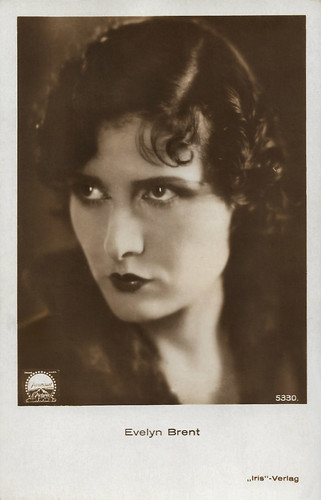
Austrian postcard by Iris-Verlag, no. 5330. Photo: Paramount.
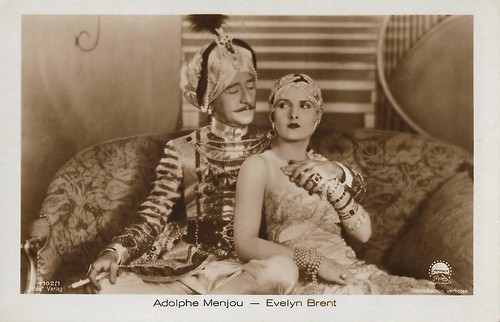
German postcard by Ross Verlag, no. 4102/1, 1929-1930. Photo: Paramount. Adolphe Menjou and Evelyn Brent in His Tiger Wife (Hobart Henley, 1928).
Four years in England
Evelyn Brent was born as Mary Elizabeth Riggs in 1899. 'Betty' was a child of 10 when her mother Eleanor died, leaving her father Arthur to raise her alone. After moving to New York City as a teenager, her good looks brought modelling jobs.
She originally studied to be a teacher. While attending a normal school in New York she visited the Popular Plays and Players Studio in Fort Lee, New Jersey, a production cooperative for distributors World Film, Pathe and Metro. Two days later she was working there as an extra making $3 a day, using her original name, Betty Riggs.
She made her major debut in the silent film production of the Robert W. Service poem, The Shooting of Dan McGrew (Herbert Blaché, 1915) for Solax Studios. As Evelyn Brent, she continued to work in film, developing into a young woman whose sultry looks were much sought after.
From 1916 on, she already had leading roles in East coast film productions. In 1917 she joined John Barrymore in Raffles the Amateur Cracksman (George Irving, 1917), about a highly educated crook with entree to the best social circles. Barrymore had personally hand-picked her as his leading lady.
Evelyn Brent then took a sabbatical for health reasons and went to England. She met American playwright Oliver Cromwell who urged her to accept an important role in the George Bernard Shaw comedy 'The Ruined Lady' at the West End.
The actress remained in England for four years. She performed for such film companies as Ideal and Stoll and with male partners like Clive Brook and Jack Trevor . In 1922, she even went to Spain as star of The Spanish Jade (John S. Robertson, 1922) opposite Charles de Rochefort , distributed in America by Paramount.
She returned in 1922 to the US, and moved to Hollywood. In 1923, she was named one of the WAMPAS Baby Stars. Douglas Fairbanks Sr. signed her but failed to find a story for her; she left his company to join Associated Authors.
Brent acted in a whole series of films at Fox in 1924, while in 1924-1926 she did a large number of films at Robertson-Cole and FBO, turning her into a popular actress in such B films as Midnight Molly (Lloyd Ingraham, 1925) and Broadway Lady (Wesley Ruggles, 1925).
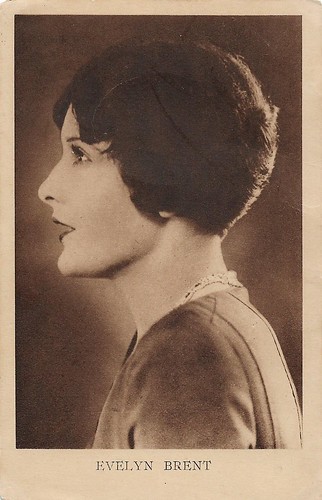
Belgian postcard by S.A. Cacao et Chocolat Kivou, Vilvoorde / N.V. Cacao en Chocolade Kivou, Vilvoorde.
A prostitute named Feathers
In the later 1920s, Evelyn Brent occasionally starred in A productions, mainly at Paramount. At Paramount, it was Josef von Sternberg who paved the way for Brent to become a top star through her role of the prostitute Feathers in Underworld (Josef von Sternberg, 1927), opposite Clive Brook and George Bancroft.
Next she appeared as Natacha Dabrova in the epic war drama The Last Command (Josef von Sternberg, 1928), opposite Emil Jannings and William Powell. In The Last Command, Brent's character saves Jannings' Grandduke Sergius during the Russian Revolution, at the expense of her own life. Jannings won the first Oscar for his part in this film and in The Way of All Flesh (Victor Fleming, 1927).
Paramount used Evelyn Brent, William Powell and Clive Brook as stars in their first feature-length all-talking film, Interference (Lothar Mendes, 1928). She was excellent as a blackmailer, but the film did not live up to expectations at the box office.
Despite that, Brent played major roles in several more features, most notably the Alaska-set romantic drama The Silver Horde (George Archainbaud, 1930) with Joel McCrea. The New York Times described the film in a critical review as 'dull and trivial' . And Brent's part in Paramount Pictures all-star revue Paramount on Parade (Edmund Goulding, a.o., 1930) was only small.
Overall, the transition to sound film ended her promising future. I.S. Mowis at IMDb : "While Evelyn's voice proved no detriment to her success in talking pictures, the declining quality of her films did." Paramount annulled their contract with Brent, who then spent the remaining years of her film career in cheap Westerns and 'quota quickies' for RKO and later for poverty row studios, such as Monogram and PRC. She also appeared in vaudeville shows.
Wikipedia : "She photographed attractively opposite leading men who were also at advanced ages and later stages in their careers: Neil Hamilton in Producers Releasing Corporation's production Dangerous Lady, Lee Tracy in the same studio's The Payoff, and Jack Holt in the serial Holt of the Secret Service, produced by Larry Darmour for Columbia Pictures. Her performances were still persuasive, and her name was still recognizable to moviegoers: theater owners often put "Evelyn Brent" on their marquees."
In the early 1940s veteran director William Beaudine cast her in many B-films, including Emergency Landing (1941), Bowery Champs (1944), The Golden Eye (1948), and Again Pioneers (1950). After performing in more than 120 films, she retired from acting in 1950 and worked for a number of years as an actor's agent.
Evelyn Brent was married three times: to film executive Bernard P. Fineman, to producer Harry D. Edwards, and finally to the vaudeville actor Harry Fox for whom the foxtrot dance was named. They were still married when he died in 1959.
Evelyn Brent died of a heart attack in 1975 at her Los Angeles home. She was cremated and interred in the San Fernando Mission Cemetery in Mission Hills. In 1960, she was awarded a star on the Hollywood Walk of Fame.
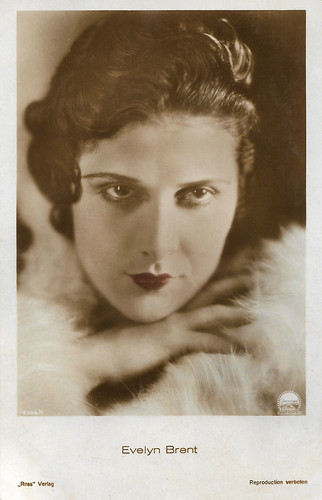
German postcard by Ross Verlag, no. 4004/1, 1929-1930. Photo: Paramount.
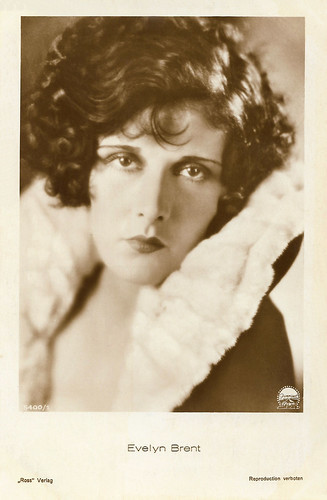
German postcard by Ross Verlag, no. 5400/1, 1930-1931. Photo: Paramount.
Sources: (IMDb), Wikipedia and .

Austrian postcard by Iris-Verlag, no. 5330. Photo: Paramount.

German postcard by Ross Verlag, no. 4102/1, 1929-1930. Photo: Paramount. Adolphe Menjou and Evelyn Brent in His Tiger Wife (Hobart Henley, 1928).
Four years in England
Evelyn Brent was born as Mary Elizabeth Riggs in 1899. 'Betty' was a child of 10 when her mother Eleanor died, leaving her father Arthur to raise her alone. After moving to New York City as a teenager, her good looks brought modelling jobs.
She originally studied to be a teacher. While attending a normal school in New York she visited the Popular Plays and Players Studio in Fort Lee, New Jersey, a production cooperative for distributors World Film, Pathe and Metro. Two days later she was working there as an extra making $3 a day, using her original name, Betty Riggs.
She made her major debut in the silent film production of the Robert W. Service poem, The Shooting of Dan McGrew (Herbert Blaché, 1915) for Solax Studios. As Evelyn Brent, she continued to work in film, developing into a young woman whose sultry looks were much sought after.
From 1916 on, she already had leading roles in East coast film productions. In 1917 she joined John Barrymore in Raffles the Amateur Cracksman (George Irving, 1917), about a highly educated crook with entree to the best social circles. Barrymore had personally hand-picked her as his leading lady.
Evelyn Brent then took a sabbatical for health reasons and went to England. She met American playwright Oliver Cromwell who urged her to accept an important role in the George Bernard Shaw comedy 'The Ruined Lady' at the West End.
The actress remained in England for four years. She performed for such film companies as Ideal and Stoll and with male partners like Clive Brook and Jack Trevor . In 1922, she even went to Spain as star of The Spanish Jade (John S. Robertson, 1922) opposite Charles de Rochefort , distributed in America by Paramount.
She returned in 1922 to the US, and moved to Hollywood. In 1923, she was named one of the WAMPAS Baby Stars. Douglas Fairbanks Sr. signed her but failed to find a story for her; she left his company to join Associated Authors.
Brent acted in a whole series of films at Fox in 1924, while in 1924-1926 she did a large number of films at Robertson-Cole and FBO, turning her into a popular actress in such B films as Midnight Molly (Lloyd Ingraham, 1925) and Broadway Lady (Wesley Ruggles, 1925).

Belgian postcard by S.A. Cacao et Chocolat Kivou, Vilvoorde / N.V. Cacao en Chocolade Kivou, Vilvoorde.
A prostitute named Feathers
In the later 1920s, Evelyn Brent occasionally starred in A productions, mainly at Paramount. At Paramount, it was Josef von Sternberg who paved the way for Brent to become a top star through her role of the prostitute Feathers in Underworld (Josef von Sternberg, 1927), opposite Clive Brook and George Bancroft.
Next she appeared as Natacha Dabrova in the epic war drama The Last Command (Josef von Sternberg, 1928), opposite Emil Jannings and William Powell. In The Last Command, Brent's character saves Jannings' Grandduke Sergius during the Russian Revolution, at the expense of her own life. Jannings won the first Oscar for his part in this film and in The Way of All Flesh (Victor Fleming, 1927).
Paramount used Evelyn Brent, William Powell and Clive Brook as stars in their first feature-length all-talking film, Interference (Lothar Mendes, 1928). She was excellent as a blackmailer, but the film did not live up to expectations at the box office.
Despite that, Brent played major roles in several more features, most notably the Alaska-set romantic drama The Silver Horde (George Archainbaud, 1930) with Joel McCrea. The New York Times described the film in a critical review as 'dull and trivial' . And Brent's part in Paramount Pictures all-star revue Paramount on Parade (Edmund Goulding, a.o., 1930) was only small.
Overall, the transition to sound film ended her promising future. I.S. Mowis at IMDb : "While Evelyn's voice proved no detriment to her success in talking pictures, the declining quality of her films did." Paramount annulled their contract with Brent, who then spent the remaining years of her film career in cheap Westerns and 'quota quickies' for RKO and later for poverty row studios, such as Monogram and PRC. She also appeared in vaudeville shows.
Wikipedia : "She photographed attractively opposite leading men who were also at advanced ages and later stages in their careers: Neil Hamilton in Producers Releasing Corporation's production Dangerous Lady, Lee Tracy in the same studio's The Payoff, and Jack Holt in the serial Holt of the Secret Service, produced by Larry Darmour for Columbia Pictures. Her performances were still persuasive, and her name was still recognizable to moviegoers: theater owners often put "Evelyn Brent" on their marquees."
In the early 1940s veteran director William Beaudine cast her in many B-films, including Emergency Landing (1941), Bowery Champs (1944), The Golden Eye (1948), and Again Pioneers (1950). After performing in more than 120 films, she retired from acting in 1950 and worked for a number of years as an actor's agent.
Evelyn Brent was married three times: to film executive Bernard P. Fineman, to producer Harry D. Edwards, and finally to the vaudeville actor Harry Fox for whom the foxtrot dance was named. They were still married when he died in 1959.
Evelyn Brent died of a heart attack in 1975 at her Los Angeles home. She was cremated and interred in the San Fernando Mission Cemetery in Mission Hills. In 1960, she was awarded a star on the Hollywood Walk of Fame.

German postcard by Ross Verlag, no. 4004/1, 1929-1930. Photo: Paramount.

German postcard by Ross Verlag, no. 5400/1, 1930-1931. Photo: Paramount.
Sources: (IMDb), Wikipedia and .
Published on July 13, 2019 22:00
July 12, 2019
Konstantin Stanislavski and the Moscow Art Theatre
Konstantin Stanislavski (1863-1938) was an outstanding Russian character actor and one of the leading theatre directors of his generation. He founded the legendary Moscow Art Theatre (MAT), and originated 'method acting'. Stanislavski's System of actor training, preparation, and rehearsal technique was spread over the world by his students, including Michael Chekhov, Aleksei Dikij, Stella Adler, Viktor Tourjansky, and Richard Boleslawski.
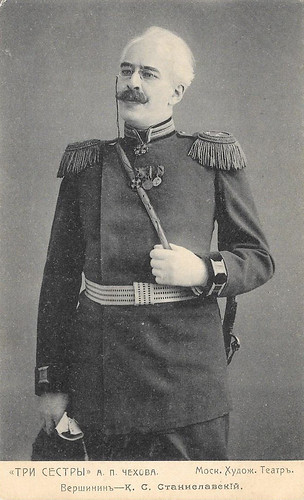
Russian postcard. Konstantin Stanislavski as Lieutenant-colonel Aleksandr Ignatyevich Vershinin in 'Три сeстры/Tri sestry/Three Sisters' by Anton Chekhov. The play, written in 1900, was first performed in 1901 at the Moscow Art Theatre. Collection: Didier Hanson.
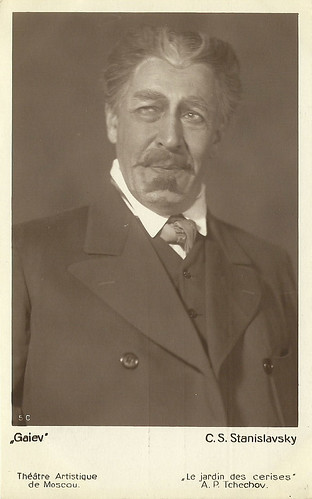
French postcard, no. 5 C. Konstantin Stanislavski as Gaiev in 'The Cherry Orchard' by Anton Chekhov, Moscow Art Theatre. Collection: Didier Hanson.
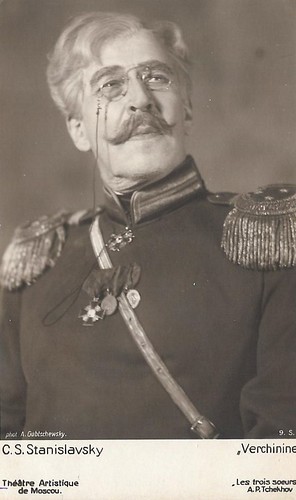
French postcard, no. 9 S. Photo: A. Gubtschewsky. Konstantin Stanislavski as Verchinine in 'Three Sisters' by Anton Chekhov, Moscow Art Theatre. Collection: Didier Hanson.
An Actor of Feeling
Konstantin Sergeievich Stanislavski (Константи́н Серге́евич Станисла́вский) (1863–1938) was a Russian actor and theatre director. The eponymous Stanislavsky method, or simply 'method acting', has had a pervasive influence on the American theatre and cinema, especially in the period after World War II.
Stanislavski treated theatre-making as a serious endeavour requiring dedication, discipline and integrity. Throughout his life, he subjected his own acting to a process of rigorous artistic self-analysis and reflection. His development of a theorised praxis — in which practice is used as a mode of inquiry and theory as a catalyst for creative development —identifies him as one of the great modern theatre practitioners.
Stanislavski's work was as important to the development of socialist realism in the Soviet Union as it was to that of psychological realism in the United States. It draws on a wide range of influences and ideas, including his study of the modernist and avant-garde developments of his time (naturalism, symbolism and Meyerhold's constructivism), Russian formalism, Yoga, Pavlovian behavioural psychology, James-Lange (via Ribot) psychophysiology and the aesthetics of Pushkin, Gogol, and Tolstoy.
He described his approach as 'spiritual Realism'. Stanislavski wrote several works, including 'An Actor Prepares', 'An Actor's Work on a Role', and his autobiography, 'My Life in Art'.
In 1885, Stanislavski briefly studied at the Moscow Theatre School, where students were encouraged to mimic the theatrical tricks and conventions of their tutors. Disappointed by this approach, he left after little more than two weeks. Instead, Stanislavski devoted particular attention to the performances of the Maly Theatre, the home of psychological realism in Russia.
Psychological realism had been developed here by Alexander Pushkin, Nikolai Gogol and Mikhail Shchepkin. Shchepkin was the father of Russian realistic acting who, in 1848, promoted the idea of an 'actor of feeling.' This actor would 'become the character' and identify with his thoughts and feelings: he would "walk, talk, think, feel, cry, laugh as the author wants him to."
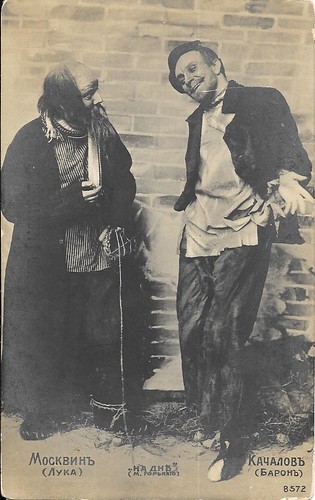
Russian postcard, no. 8572. Photo: publicity still for the Moscow Art Theatre production of 'The Lower Depths'(1902) by Maxim Gorky, with Ivan Moskvin as Luka and Vasili Kachalov as the Baron. Collection: Didier Hanson.
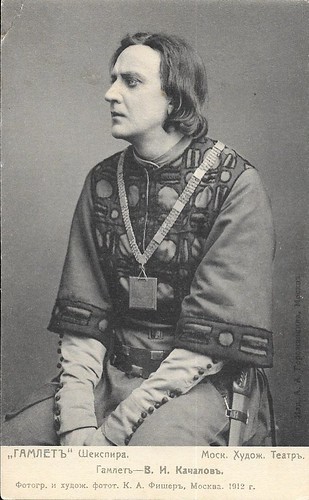
Russian postcard. Vasily Kachalov as Hamlet in The Moscow Art Theatre (MAT) production of 'Hamlet' (1911–1912). Collection: Didier Hanson.
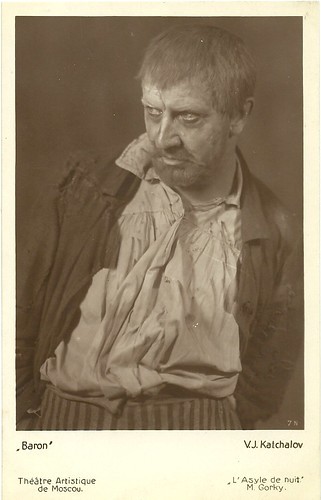
French postcard, no. 7 N. Vasily Kachalov as The Baron in The Moscow Art Theatre (MAT) production of The Lower Depths (1902) by Maxim Gorky. Collection: Didier Hanson.
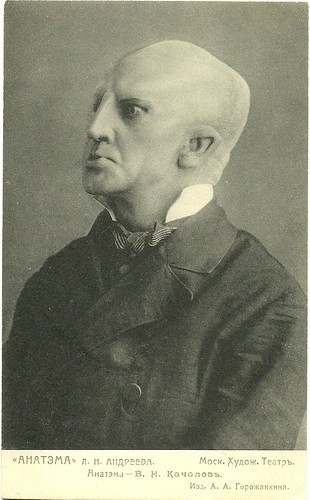
Russian postcard. Vasily Kachalov as Anathema in the prologue in The Moscow Art Theatre (MAT) production of Anathema (1909) by Leonid Andreev. Collection: Didier Hanson.
The principle of opposites
By the age of twenty-five, Konstantin Stanislavski was well known as an amateur actor. He made a proposal to Fyodor Sollogub and theatre director Alexander Fedotov to establish a society that would unite amateur and professional actors and artists. They founded in 1888 The Society of Art and Literature. Fedotov became head of the dramatic section, Komissarzhevski was the head of the operatic and musical section, while Sollogub was appointed head of the graphic arts section; the drama and opera sections each had a school.
In 1889 in the society's production of Aleksey Pisemsky's historical play 'Men Above The Law', Stanislavski discovered his 'principle of opposites,' as expressed in his aphoristic advice to the actor: "When you play a good man, try to find out where he is bad, and when you play a villain, try to find where he is good." Stanislavski insisted that the actors learnt their parts thoroughly, almost entirely removing the prompter from the society's productions.
It was Stanislavski's historic meeting with playwright Vladimir Nemirovich-Danchenko in 1897, however, that would create the Moscow Art Theatre (MAT). In 1898, Stanislavski co-directed with Nemirovich the first of his productions of the work of Anton Chekhov. The MAT production of 'The Seagull' was a crucial milestone for the fledgling company that has been described as "one of the greatest events in the history of Russian theatre and one of the greatest new developments in the history of world drama."
Stanislavski went on to direct the successful premières of Chekhov's other major plays: 'Uncle Vanya' in 1899, 'Three Sisters' in 1901, and 'The Cherry Orchard' in 1904. Stanislavski's encounter with Chekhov's drama proved crucial to the creative development of both men. His ensemble approach and attention to the psychological realities of its characters revived Chekhov's interest in writing for the stage, while Chekhov's unwillingness to explain or expand on the text forced Stanislavski to dig beneath its surface in ways that were new in theatre.
Stanislavski had different pupils during each of the phases of discovering and experimenting with his 'system' of acting. Two of his former students, Richard Boleslavsky and Maria Ouspenskaya, founded the American Laboratory Theatre in 1925. One of their students, Lee Strasberg, went on to co-found the Group Theatre (1931–1940) with Harold Clurman and Cheryl Crawford, which was the first American acting company to put Stanislavski's initial discoveries into practice.
Clurman and Strasberg had a profound influence on American acting, both on stage and film, as did Stella Adler, who was also part of the Group Theatre and who had studied briefly with Stanislavsky and quarrelled with Strasberg's approach to the work. Sanford Meisner, another Group member, joined with Adler in opposing Strasberg's approach. This conflict was the partial cause of the Group Theatre's dissolution. After the Group broke up, Strasberg, Adler and Meisner each went on to found their own acting studios which trained many of the most prominent actors in American theatre and film.
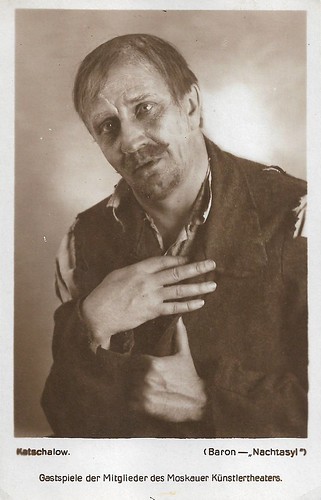
German postcard. Vasili Kachalov as Baron in Maxim Gorky's 'The Lower Depths', Moscow Art Theatre.
Russian film and stage actor Vasily Kachalov (1875-1948) was one of Konstantin Stanislavsky's best-known performers. He led the so-called Kachalov Group within the Moscow Art Theatre. He also appeared in four films.

German postcard. Mariya Germanova as Olga in 'Three Sisters', by Anton Chekhov. Caption: Guest performances by the Moscow Art Theatre (in Germany, 1920s).
Mariya Germanova (1884–1940) was known for such films as Anna Karenina (1914) and Raskolnikow (Robert Wiene, 1923). In 1901 she enrolled in the just opened Moscow Art Theatre Drama School and a year later joined the Moscow Art Theatre. Debuting in Shakespeare's 'Julius Caesar' in 1903, she got positive reviews in Maxim Gorky's 'Children of the Sun' (1905), in Griboyedov's 'Woe from Wit' and in Henrik Ibsen's 'Brand' (both 1906).
Vladimir Nemirovich-Danchenko relied mostly upon her stage persona in his stage experiments like 'Boris Godunov' by Alexander Pushkin (1907), 'Anathema' by Leonid Andreyev (1909), 'The Karamazov Brothers' by Dostoyevsky (1910), Leo Tolstoy's 'The Living Corpse' (1911). In late 1920s she started working as theatre director herself. In 1929 she went to the US and that year she succeeded Richard Boleslawski as the head of the American Laboratory Theatre, where she produced Chekhov's 'Three Sisters'. The Lab, as it was known, disbanded in 1933, but proved to be an important link between Stanislavski and the New York's Group Theatre.
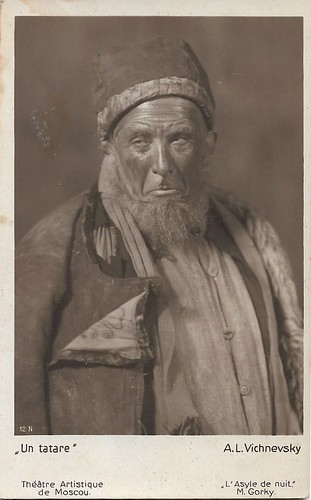
French postcard. Alexander Vishnevsky as A Tartar in Maxim Gorki's 'The Lower Depths', Moscow Art Theatre.
Aleksandr Leonid Vishnevsky (1861-1943) was one of the founding members of the Moscow Art Theatre. Vishnevsky studied at the Taganrog gymnasium where he befriended the young Anton Chekhov. From 1883 he took part in the performances of the Taganrog Music and Drama Society. Later he acted in the theatres of Kharkov, Ekaterinoslav, Odessa, Saratov where he was a jeune premier.
In 1898 he joined the troupe of the Moscow Art Theatre (MAT). On the opening night of the MAT, Vishnevsky played the part of Boris Godunov in the play 'Tsar Fiodor Ioannovich' by Alexei Tolstoy. In 1899 he played Godunov again in Tolstoy's 'The Death of Ivan the Terrible'. Vishnevsky was the first to play the title role in Chekhov's play 'Uncle Vanya' at the MAT. Vishnevsky acted in three films: Cagliostro (Wladyslaw Starewicz, 1918), Pobeda zhenshchiny (Yuri Zhelyabuzhsky, 1927), and the comedy Prazdnik svyatogo/Holiday of St. Jorgen Yorgena (Yakov Protazanov, Porfiri Podobed, 1930).
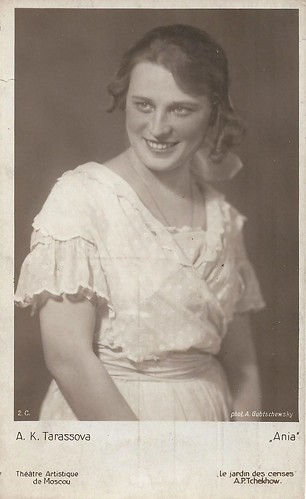
French postcard, no. 2 C. Photo: A. Gubtschewsky. Alla Tarassova as Anya in 'The Cherry Orchard', Moscow Art Theatre.
Alla Tarassova (1898-1973) started to play in productions of the Moscow Art Theatre in 1916. She made a mark already in 1916 as Boyar woman in 'Tsar Fedor Ioannovich' by Alexander Tolstoy. During the Civil War, she toured from 1919 to 1922 with the Kachalov Group. It was here she broke through as Anya in 'The Cherry Orchard', Verushka in 'Autumn Violins', The Maid in 'Three Sisters', and Ophelia in 'Hamlet'. She toured Europe and the US in 1922-1924, where she also lived for a while. From 1923 till 1971 Tarassova was a regular of the Moscow Art Theatre, playing e.g. Nastya in 'The Lower Depths' by Gorki in 1923. Together with many of the Moscow Art Theatre group, Tarassova played in 1923 in the classic German Expressionist Raskolnikow (Robert Wiene, 1923). Tarassova performed the sister of the title character, played by Gregori Chmara. Back in the Soviet Union, she acted as Mary in Kto ty takoy?/Who Are You (Yuri Zhelyabuzhsky, 1927; not listed in IMDb) and had the lead in the silent film Vasilisina pobeda (Leonid Molchanov, 1928).
In the 1930s Tarassova acted in various Russian films. She starred as Katerina Petrovna Kabanova in Groza/The Storm (Vladimir Petrov, 1933), awarded at the 1934 Venice film festival. She also had a lead in Dreamers/The Rise of Man, or Is Russia in the Dark? (David Marian, 1934; not listed in IMDb). In the two-part biopic Пётр Первый/Peter the Great (1937-38), she played Yekaterina/ Catherine, a peasant girl, who will become the powerful Tzarina Catherine in part II. In 1940 Tarassova starred in Бабы/Baby (Vladimir Batalov, 1940). In 1952 she repeated her former stage role of Nastya in the film adaptation of 'The Lower Depths', Na dne (Andrey Frolov, 1952), a faithful adaptation of Stanislavski's direction of the play in the late 1930s. In 1953 Tarassova played the title role in Tolstoy's Anna Karenina, a recording of the stage performance by the Moscow Art Theatre, directed by Tatyana Lukashevich.
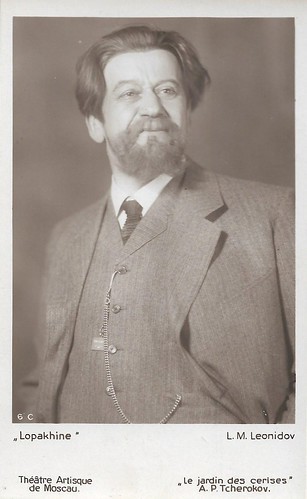
French postcard. 6 C. Leonid Leonidov as Lopakhin in Anton Chekhov's play 'The Cherry Orchard', Moscow Art Theatre.
Leonid Mironovich Leonidov (1873-1941) worked at the Moscow Art Theatre from 1903. Stanislavski called Leonidov "the only Russian tragic actor." His roles included Dmitri Karamazov, Othello, and Lopakhin in The Cherry Orchard. In the late 1910s, 1920s, and 1930s, Leonidov also appeared in several films. He started in the propaganda film Khleb/Bread (Richard Boleslawski, Boris Sushkevich, 1918) with Olga Baclanova and Boleslawski himself, followed by Zheleznaya pyata/The Iron Heel (Vladimir Gardin, 1919) with Aleksandra Khokhlova and based on a Jack London novel; and Pyotr i Alexei (Yuri Zhelyabuzhsky, 1919) in which he had the lead as Tsar Peter the Great.
In 1926 Leonidov returned to the sets, again as tsar, but now as Ivan the Terrible in the Sovkino production Krylya kholopa/The Wings of a Serf (Yuri Tarich, 1926), which was also shown in the West. In 1928 he played a double leading role in Yego prevoskhoditelstvo/His Excellency (Grigoriy Roshal, 1928), about a rabbi who in 1902 attempts to murder a governor who had workers flogged for a May-Day rally. Leonidov played both the rabbi and the governor. In the same year 1928, Leonidov also had the lead in the Mezhrabpomfilm production V gorod vkhodit' nelzya (Yuri Zhelyabuzhsky, 1928). In the sound era, Leonidov acted in two Russian films, as a munition manufacturer in the political pamphlet against the fascists, Marionetki/The Marionettes (Yakov Protazanov, Porfiri Podobed, 1934) and as the title character in Gobzek (Konstantin Eggert, 1937).
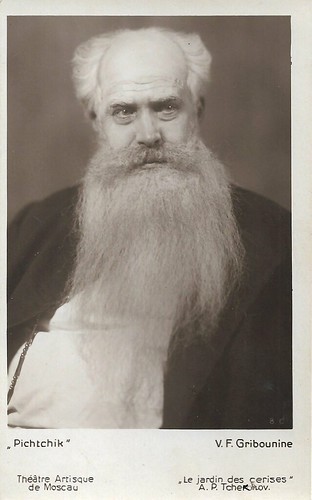
French postcard, no. 8 C. Vladimir Gribunin as Simeonov-Pishchik in Anton Chekhov's 'The Cherry Orchard', Moscow Art Theatre.
Vladimir Fyodorovich Gribunin (1873-1933) learned drama at the Maly Theatre Drama college in the class of Mikhail Sadovsky, then joined the Moscow Art Theatre in 1898 with which he stayed until his death in 1933. Critically lauded were his performances as Nikita in Leo Tolstoy's 'Power of Darkness', Simeonov-Pishchik in Anton Chekhov's 'The Cherry Orchard' and Kuroslepov in the 1926 production of Alexander Ostrovsky's 'An Ardent Heart'. The latter is considered to be the high point of his artistic career. He was cast in three early Soviet films: Алёшина дудка/Alyosha's Pipe (Vladimir Kasyanov 1919), Трое/Threesome (Michael Narokov 1919) and Хромой барин/Limping Landlord (Vladimir Kasyanov, 1920).
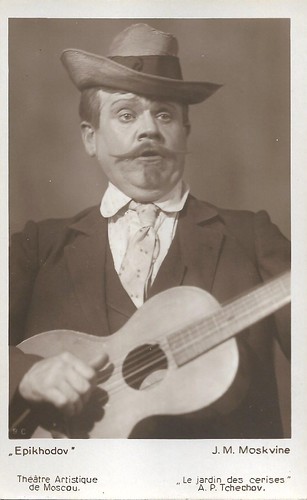
French postcard, no. 9 C. Ivan Moskvin as Yepikhodov in Anton Chekhov's play 'The Cherry Orchard', Moscow Art Theatre.
The career of Ivan Moskvin (1874-1946) is closely identified with the Moscow Art Theatre, of which he became director in 1943. In 1898 he was invited by Vladimir Nemirovich-Danchenko to join the newly formed MAT, and he appeared opposite Olga Knipper in the title role of the theatre’s first production, 'Czar Fyodor Ioannovich' (1898), by Aleksey Tolstoy. He went on to create the role of Luka in Maxim Gorky’s 'The Lower Depths' (1902) and Epikhodoff in Anton Chekhov’s 'The Cherry Orchard' (1904).
The international acclaim Moskvin won when touring Europe and the United States (1919–1924) was reinforced in later years by his work in Soviet films that were distributed worldwide. Among Moskvin’s film roles were e.g. the Russian serf in the Tolstoy adaptation Polikushka (Alexander Sanin, 1922), the government clerk in the Chekhov adaptation Chiny i lyudi/Ranks and People (Mikhail Doller, Yakov Protazanov, 1929), and the title role in the Pushkin adaptation Kollezhskiy registrator/The Station Master (Ivan Moskvin himself with Yuri Zhelyabuzhsky, 1925), also with Vera Malinovskaya. Moskvin was a much-respected teacher with three generations of Moscow Art Theatre actors, and he continued to appear in the theatre’s productions through 1942 when he played a principal role in N.F. Pogodin’s 'Kremlin Chimes'.

French postcard, no. 9 N. Ivan Moskvin as Luka in Maxim Gorky's play The Lower Depths, Moscow Art Theatre.
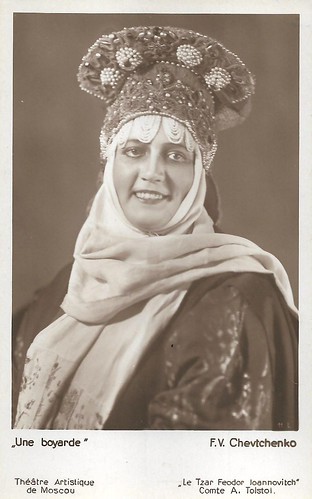
French postcard, no. 11 L. Faina Shevchenko as A Boyar Woman in Aleksey Tolstoy's 'Tsar Fyodor Ioannovich', Moscow Art Theatre.
Faina Vasilyevna Shevchenko aka Faïna Chevtchenko (1893-1971) was the People's Artist of the USSR (1948) and the recipient of several high-profile state awards (including the Order of Lenin, 1938) and twice the Stalin Prize laureate (1943, 1946). She was one of the leading actresses of the Moscow Art Theatre where she debuted in 1914 and stayed until 1959. Shevchenko excelled in Russian drama classics and was best remembered for her roles in the plays by Alexander Ostrovsky, including 'Enough Stupidity in Every Wise Man' (1920), 'An Ardent Heart' (1926), 'The Storm' (1934), 'The Last Victim' (1944) and 'The Forest' (1948), as well as plays by Maxim Gorky, including 'The Lower Depths' (1916). She was also a successful singer with folk songs.
Shevchenko was cast in seven sound films, including the Georgian spoken David Guramishvili (Nikoloz Sanishvili, Joseb Tumanishvili, 1946) where she played the Russian Empress, The Composer Glinka (Grigoriy Aleksandrov, 1952) where she was Mme Ivanovich, and The Lower Depths (Andrey Frolov, 1952). "Dazzlingly simple, vivid, filled to the brim with life, endowed with huge temperament and open heart," was how the theatre historian Pavel Markov described her in his book of memoirs. Shevchenko was said to be the artist Boris Kustodiev's favourite model and, as a 21-year-old, sat nude for his The Beauty sessions. This daring venture caused scandal and almost cost Shevchenko her place in the troupe.
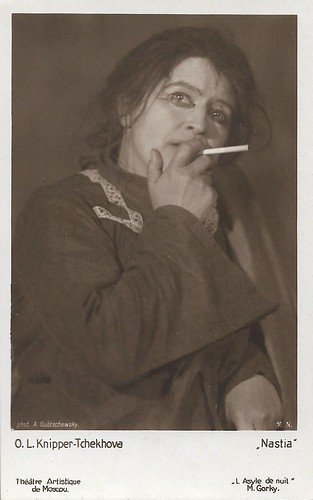
French postcard, no. 16 N. Photo A. Gubtschewsky, Berlin. Olga Knipper-Chekhova as Nastia in Maxim Gorky's 'The Lower Depths', Moscow Art Theatre.
Olga Leonárdovna Knipper-Chekhova (1868-1959 ) was a Russian actress. After marrying Antón Chékhov in 1901, she added the surname of the writer to her father's name. She was one of the 39 members of the Moscow Art Theatre when Konstantin Stanislavski formed it in 1898. She played the role of Arkadyina in 'The Seagull' (1898) and was the first person to star as Masha in 'Three Sisters' (1901) and Madame Ranévskaya in 'The Cherry Orchard' (1904). In 1901 Knipper married Antón Chékhov, the author of these stageplays, but the wedding was almost done in secret. Three years after, in 1904, Chekhov would die of tuberculosis.
In 1919, Knipper fled the famine with her company by moving first to Kharkiv, then the Crimea, Georgia, Bulgaria, and Yugoslavia, before returning to the Soviet Union in 1922. She then went on an official stage tour to France and the United States. At her return, she passed Germany, where her niece Olga was starting a career in silent cinema. Olga Knipper herself played in three films, the silent film Plenniki morya/Prisoners of the Sea (Mikhail Verner, 1929), Zavtra nochyu/Tomorrow Night (Ilya Kravchunovsky, 1930), and Mastera stseny (Vladimir Yurenev, 1947), in which she reprised her part of Madame Ranévskaya. Olga Knipper continued a successful stage career with the Moscow Art Theatre. She played the role of Ranévskaya again in 1943 to celebrate the three hundredth representation of 'The Cherry Orchard'.
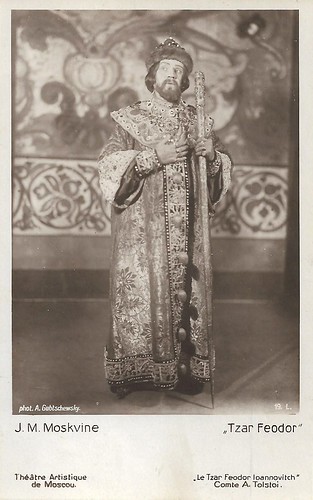
French postcard,no. 19 L. Photo: A. Gubtchewsky, Berlin. Ivan Moskvin as Tsar Fyodor in Aleksey Tolstoy's 'Tsar Fyodor Ioannovich', Moscow Art Theatre.
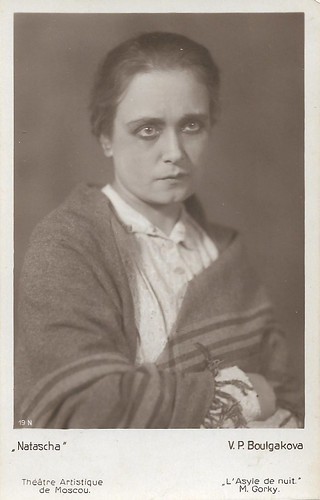
French postcard, no. 19 N. Barbara Bulgakova as Natasha in Maxim Gorki's 'The Lower Depths', Moscow Art Theatre.
Barbara Bulgakova aka Barbara Bulgakov (c. 1898-1977) was the wife of actor, stage and film director Leo Bulgakov. Both were regulars from the Moscow Art Theatre (MAT) from an early date. As Varvara Bulgakova, she had her first film part in Polikushka (1922), starring Moscow Art Theatre actor Ivan Moskvin. The Bulgakovs were part of the MAT troupe that officially toured Europe and the States in the early 1920s.
When the troupe returned to Russia, Bulgakov and his wife remained in the US. They started to act in shows on Broadway, which Leo Bulgakov partly also produced himself, including classic Russian plays such as 'The Seagull', 'The Lower Depths', etc. He also directed and acted in various films. Barbara acted with her husband in Song of Russia (Gregory Ratoff, Laslo Benedek, 1944). After the death of her husband in 1948, she also acted in a few TV plays.
Sources: Wikipedia and .

Russian postcard. Konstantin Stanislavski as Lieutenant-colonel Aleksandr Ignatyevich Vershinin in 'Три сeстры/Tri sestry/Three Sisters' by Anton Chekhov. The play, written in 1900, was first performed in 1901 at the Moscow Art Theatre. Collection: Didier Hanson.

French postcard, no. 5 C. Konstantin Stanislavski as Gaiev in 'The Cherry Orchard' by Anton Chekhov, Moscow Art Theatre. Collection: Didier Hanson.

French postcard, no. 9 S. Photo: A. Gubtschewsky. Konstantin Stanislavski as Verchinine in 'Three Sisters' by Anton Chekhov, Moscow Art Theatre. Collection: Didier Hanson.
An Actor of Feeling
Konstantin Sergeievich Stanislavski (Константи́н Серге́евич Станисла́вский) (1863–1938) was a Russian actor and theatre director. The eponymous Stanislavsky method, or simply 'method acting', has had a pervasive influence on the American theatre and cinema, especially in the period after World War II.
Stanislavski treated theatre-making as a serious endeavour requiring dedication, discipline and integrity. Throughout his life, he subjected his own acting to a process of rigorous artistic self-analysis and reflection. His development of a theorised praxis — in which practice is used as a mode of inquiry and theory as a catalyst for creative development —identifies him as one of the great modern theatre practitioners.
Stanislavski's work was as important to the development of socialist realism in the Soviet Union as it was to that of psychological realism in the United States. It draws on a wide range of influences and ideas, including his study of the modernist and avant-garde developments of his time (naturalism, symbolism and Meyerhold's constructivism), Russian formalism, Yoga, Pavlovian behavioural psychology, James-Lange (via Ribot) psychophysiology and the aesthetics of Pushkin, Gogol, and Tolstoy.
He described his approach as 'spiritual Realism'. Stanislavski wrote several works, including 'An Actor Prepares', 'An Actor's Work on a Role', and his autobiography, 'My Life in Art'.
In 1885, Stanislavski briefly studied at the Moscow Theatre School, where students were encouraged to mimic the theatrical tricks and conventions of their tutors. Disappointed by this approach, he left after little more than two weeks. Instead, Stanislavski devoted particular attention to the performances of the Maly Theatre, the home of psychological realism in Russia.
Psychological realism had been developed here by Alexander Pushkin, Nikolai Gogol and Mikhail Shchepkin. Shchepkin was the father of Russian realistic acting who, in 1848, promoted the idea of an 'actor of feeling.' This actor would 'become the character' and identify with his thoughts and feelings: he would "walk, talk, think, feel, cry, laugh as the author wants him to."

Russian postcard, no. 8572. Photo: publicity still for the Moscow Art Theatre production of 'The Lower Depths'(1902) by Maxim Gorky, with Ivan Moskvin as Luka and Vasili Kachalov as the Baron. Collection: Didier Hanson.

Russian postcard. Vasily Kachalov as Hamlet in The Moscow Art Theatre (MAT) production of 'Hamlet' (1911–1912). Collection: Didier Hanson.

French postcard, no. 7 N. Vasily Kachalov as The Baron in The Moscow Art Theatre (MAT) production of The Lower Depths (1902) by Maxim Gorky. Collection: Didier Hanson.

Russian postcard. Vasily Kachalov as Anathema in the prologue in The Moscow Art Theatre (MAT) production of Anathema (1909) by Leonid Andreev. Collection: Didier Hanson.
The principle of opposites
By the age of twenty-five, Konstantin Stanislavski was well known as an amateur actor. He made a proposal to Fyodor Sollogub and theatre director Alexander Fedotov to establish a society that would unite amateur and professional actors and artists. They founded in 1888 The Society of Art and Literature. Fedotov became head of the dramatic section, Komissarzhevski was the head of the operatic and musical section, while Sollogub was appointed head of the graphic arts section; the drama and opera sections each had a school.
In 1889 in the society's production of Aleksey Pisemsky's historical play 'Men Above The Law', Stanislavski discovered his 'principle of opposites,' as expressed in his aphoristic advice to the actor: "When you play a good man, try to find out where he is bad, and when you play a villain, try to find where he is good." Stanislavski insisted that the actors learnt their parts thoroughly, almost entirely removing the prompter from the society's productions.
It was Stanislavski's historic meeting with playwright Vladimir Nemirovich-Danchenko in 1897, however, that would create the Moscow Art Theatre (MAT). In 1898, Stanislavski co-directed with Nemirovich the first of his productions of the work of Anton Chekhov. The MAT production of 'The Seagull' was a crucial milestone for the fledgling company that has been described as "one of the greatest events in the history of Russian theatre and one of the greatest new developments in the history of world drama."
Stanislavski went on to direct the successful premières of Chekhov's other major plays: 'Uncle Vanya' in 1899, 'Three Sisters' in 1901, and 'The Cherry Orchard' in 1904. Stanislavski's encounter with Chekhov's drama proved crucial to the creative development of both men. His ensemble approach and attention to the psychological realities of its characters revived Chekhov's interest in writing for the stage, while Chekhov's unwillingness to explain or expand on the text forced Stanislavski to dig beneath its surface in ways that were new in theatre.
Stanislavski had different pupils during each of the phases of discovering and experimenting with his 'system' of acting. Two of his former students, Richard Boleslavsky and Maria Ouspenskaya, founded the American Laboratory Theatre in 1925. One of their students, Lee Strasberg, went on to co-found the Group Theatre (1931–1940) with Harold Clurman and Cheryl Crawford, which was the first American acting company to put Stanislavski's initial discoveries into practice.
Clurman and Strasberg had a profound influence on American acting, both on stage and film, as did Stella Adler, who was also part of the Group Theatre and who had studied briefly with Stanislavsky and quarrelled with Strasberg's approach to the work. Sanford Meisner, another Group member, joined with Adler in opposing Strasberg's approach. This conflict was the partial cause of the Group Theatre's dissolution. After the Group broke up, Strasberg, Adler and Meisner each went on to found their own acting studios which trained many of the most prominent actors in American theatre and film.

German postcard. Vasili Kachalov as Baron in Maxim Gorky's 'The Lower Depths', Moscow Art Theatre.
Russian film and stage actor Vasily Kachalov (1875-1948) was one of Konstantin Stanislavsky's best-known performers. He led the so-called Kachalov Group within the Moscow Art Theatre. He also appeared in four films.

German postcard. Mariya Germanova as Olga in 'Three Sisters', by Anton Chekhov. Caption: Guest performances by the Moscow Art Theatre (in Germany, 1920s).
Mariya Germanova (1884–1940) was known for such films as Anna Karenina (1914) and Raskolnikow (Robert Wiene, 1923). In 1901 she enrolled in the just opened Moscow Art Theatre Drama School and a year later joined the Moscow Art Theatre. Debuting in Shakespeare's 'Julius Caesar' in 1903, she got positive reviews in Maxim Gorky's 'Children of the Sun' (1905), in Griboyedov's 'Woe from Wit' and in Henrik Ibsen's 'Brand' (both 1906).
Vladimir Nemirovich-Danchenko relied mostly upon her stage persona in his stage experiments like 'Boris Godunov' by Alexander Pushkin (1907), 'Anathema' by Leonid Andreyev (1909), 'The Karamazov Brothers' by Dostoyevsky (1910), Leo Tolstoy's 'The Living Corpse' (1911). In late 1920s she started working as theatre director herself. In 1929 she went to the US and that year she succeeded Richard Boleslawski as the head of the American Laboratory Theatre, where she produced Chekhov's 'Three Sisters'. The Lab, as it was known, disbanded in 1933, but proved to be an important link between Stanislavski and the New York's Group Theatre.

French postcard. Alexander Vishnevsky as A Tartar in Maxim Gorki's 'The Lower Depths', Moscow Art Theatre.
Aleksandr Leonid Vishnevsky (1861-1943) was one of the founding members of the Moscow Art Theatre. Vishnevsky studied at the Taganrog gymnasium where he befriended the young Anton Chekhov. From 1883 he took part in the performances of the Taganrog Music and Drama Society. Later he acted in the theatres of Kharkov, Ekaterinoslav, Odessa, Saratov where he was a jeune premier.
In 1898 he joined the troupe of the Moscow Art Theatre (MAT). On the opening night of the MAT, Vishnevsky played the part of Boris Godunov in the play 'Tsar Fiodor Ioannovich' by Alexei Tolstoy. In 1899 he played Godunov again in Tolstoy's 'The Death of Ivan the Terrible'. Vishnevsky was the first to play the title role in Chekhov's play 'Uncle Vanya' at the MAT. Vishnevsky acted in three films: Cagliostro (Wladyslaw Starewicz, 1918), Pobeda zhenshchiny (Yuri Zhelyabuzhsky, 1927), and the comedy Prazdnik svyatogo/Holiday of St. Jorgen Yorgena (Yakov Protazanov, Porfiri Podobed, 1930).

French postcard, no. 2 C. Photo: A. Gubtschewsky. Alla Tarassova as Anya in 'The Cherry Orchard', Moscow Art Theatre.
Alla Tarassova (1898-1973) started to play in productions of the Moscow Art Theatre in 1916. She made a mark already in 1916 as Boyar woman in 'Tsar Fedor Ioannovich' by Alexander Tolstoy. During the Civil War, she toured from 1919 to 1922 with the Kachalov Group. It was here she broke through as Anya in 'The Cherry Orchard', Verushka in 'Autumn Violins', The Maid in 'Three Sisters', and Ophelia in 'Hamlet'. She toured Europe and the US in 1922-1924, where she also lived for a while. From 1923 till 1971 Tarassova was a regular of the Moscow Art Theatre, playing e.g. Nastya in 'The Lower Depths' by Gorki in 1923. Together with many of the Moscow Art Theatre group, Tarassova played in 1923 in the classic German Expressionist Raskolnikow (Robert Wiene, 1923). Tarassova performed the sister of the title character, played by Gregori Chmara. Back in the Soviet Union, she acted as Mary in Kto ty takoy?/Who Are You (Yuri Zhelyabuzhsky, 1927; not listed in IMDb) and had the lead in the silent film Vasilisina pobeda (Leonid Molchanov, 1928).
In the 1930s Tarassova acted in various Russian films. She starred as Katerina Petrovna Kabanova in Groza/The Storm (Vladimir Petrov, 1933), awarded at the 1934 Venice film festival. She also had a lead in Dreamers/The Rise of Man, or Is Russia in the Dark? (David Marian, 1934; not listed in IMDb). In the two-part biopic Пётр Первый/Peter the Great (1937-38), she played Yekaterina/ Catherine, a peasant girl, who will become the powerful Tzarina Catherine in part II. In 1940 Tarassova starred in Бабы/Baby (Vladimir Batalov, 1940). In 1952 she repeated her former stage role of Nastya in the film adaptation of 'The Lower Depths', Na dne (Andrey Frolov, 1952), a faithful adaptation of Stanislavski's direction of the play in the late 1930s. In 1953 Tarassova played the title role in Tolstoy's Anna Karenina, a recording of the stage performance by the Moscow Art Theatre, directed by Tatyana Lukashevich.

French postcard. 6 C. Leonid Leonidov as Lopakhin in Anton Chekhov's play 'The Cherry Orchard', Moscow Art Theatre.
Leonid Mironovich Leonidov (1873-1941) worked at the Moscow Art Theatre from 1903. Stanislavski called Leonidov "the only Russian tragic actor." His roles included Dmitri Karamazov, Othello, and Lopakhin in The Cherry Orchard. In the late 1910s, 1920s, and 1930s, Leonidov also appeared in several films. He started in the propaganda film Khleb/Bread (Richard Boleslawski, Boris Sushkevich, 1918) with Olga Baclanova and Boleslawski himself, followed by Zheleznaya pyata/The Iron Heel (Vladimir Gardin, 1919) with Aleksandra Khokhlova and based on a Jack London novel; and Pyotr i Alexei (Yuri Zhelyabuzhsky, 1919) in which he had the lead as Tsar Peter the Great.
In 1926 Leonidov returned to the sets, again as tsar, but now as Ivan the Terrible in the Sovkino production Krylya kholopa/The Wings of a Serf (Yuri Tarich, 1926), which was also shown in the West. In 1928 he played a double leading role in Yego prevoskhoditelstvo/His Excellency (Grigoriy Roshal, 1928), about a rabbi who in 1902 attempts to murder a governor who had workers flogged for a May-Day rally. Leonidov played both the rabbi and the governor. In the same year 1928, Leonidov also had the lead in the Mezhrabpomfilm production V gorod vkhodit' nelzya (Yuri Zhelyabuzhsky, 1928). In the sound era, Leonidov acted in two Russian films, as a munition manufacturer in the political pamphlet against the fascists, Marionetki/The Marionettes (Yakov Protazanov, Porfiri Podobed, 1934) and as the title character in Gobzek (Konstantin Eggert, 1937).

French postcard, no. 8 C. Vladimir Gribunin as Simeonov-Pishchik in Anton Chekhov's 'The Cherry Orchard', Moscow Art Theatre.
Vladimir Fyodorovich Gribunin (1873-1933) learned drama at the Maly Theatre Drama college in the class of Mikhail Sadovsky, then joined the Moscow Art Theatre in 1898 with which he stayed until his death in 1933. Critically lauded were his performances as Nikita in Leo Tolstoy's 'Power of Darkness', Simeonov-Pishchik in Anton Chekhov's 'The Cherry Orchard' and Kuroslepov in the 1926 production of Alexander Ostrovsky's 'An Ardent Heart'. The latter is considered to be the high point of his artistic career. He was cast in three early Soviet films: Алёшина дудка/Alyosha's Pipe (Vladimir Kasyanov 1919), Трое/Threesome (Michael Narokov 1919) and Хромой барин/Limping Landlord (Vladimir Kasyanov, 1920).

French postcard, no. 9 C. Ivan Moskvin as Yepikhodov in Anton Chekhov's play 'The Cherry Orchard', Moscow Art Theatre.
The career of Ivan Moskvin (1874-1946) is closely identified with the Moscow Art Theatre, of which he became director in 1943. In 1898 he was invited by Vladimir Nemirovich-Danchenko to join the newly formed MAT, and he appeared opposite Olga Knipper in the title role of the theatre’s first production, 'Czar Fyodor Ioannovich' (1898), by Aleksey Tolstoy. He went on to create the role of Luka in Maxim Gorky’s 'The Lower Depths' (1902) and Epikhodoff in Anton Chekhov’s 'The Cherry Orchard' (1904).
The international acclaim Moskvin won when touring Europe and the United States (1919–1924) was reinforced in later years by his work in Soviet films that were distributed worldwide. Among Moskvin’s film roles were e.g. the Russian serf in the Tolstoy adaptation Polikushka (Alexander Sanin, 1922), the government clerk in the Chekhov adaptation Chiny i lyudi/Ranks and People (Mikhail Doller, Yakov Protazanov, 1929), and the title role in the Pushkin adaptation Kollezhskiy registrator/The Station Master (Ivan Moskvin himself with Yuri Zhelyabuzhsky, 1925), also with Vera Malinovskaya. Moskvin was a much-respected teacher with three generations of Moscow Art Theatre actors, and he continued to appear in the theatre’s productions through 1942 when he played a principal role in N.F. Pogodin’s 'Kremlin Chimes'.

French postcard, no. 9 N. Ivan Moskvin as Luka in Maxim Gorky's play The Lower Depths, Moscow Art Theatre.

French postcard, no. 11 L. Faina Shevchenko as A Boyar Woman in Aleksey Tolstoy's 'Tsar Fyodor Ioannovich', Moscow Art Theatre.
Faina Vasilyevna Shevchenko aka Faïna Chevtchenko (1893-1971) was the People's Artist of the USSR (1948) and the recipient of several high-profile state awards (including the Order of Lenin, 1938) and twice the Stalin Prize laureate (1943, 1946). She was one of the leading actresses of the Moscow Art Theatre where she debuted in 1914 and stayed until 1959. Shevchenko excelled in Russian drama classics and was best remembered for her roles in the plays by Alexander Ostrovsky, including 'Enough Stupidity in Every Wise Man' (1920), 'An Ardent Heart' (1926), 'The Storm' (1934), 'The Last Victim' (1944) and 'The Forest' (1948), as well as plays by Maxim Gorky, including 'The Lower Depths' (1916). She was also a successful singer with folk songs.
Shevchenko was cast in seven sound films, including the Georgian spoken David Guramishvili (Nikoloz Sanishvili, Joseb Tumanishvili, 1946) where she played the Russian Empress, The Composer Glinka (Grigoriy Aleksandrov, 1952) where she was Mme Ivanovich, and The Lower Depths (Andrey Frolov, 1952). "Dazzlingly simple, vivid, filled to the brim with life, endowed with huge temperament and open heart," was how the theatre historian Pavel Markov described her in his book of memoirs. Shevchenko was said to be the artist Boris Kustodiev's favourite model and, as a 21-year-old, sat nude for his The Beauty sessions. This daring venture caused scandal and almost cost Shevchenko her place in the troupe.

French postcard, no. 16 N. Photo A. Gubtschewsky, Berlin. Olga Knipper-Chekhova as Nastia in Maxim Gorky's 'The Lower Depths', Moscow Art Theatre.
Olga Leonárdovna Knipper-Chekhova (1868-1959 ) was a Russian actress. After marrying Antón Chékhov in 1901, she added the surname of the writer to her father's name. She was one of the 39 members of the Moscow Art Theatre when Konstantin Stanislavski formed it in 1898. She played the role of Arkadyina in 'The Seagull' (1898) and was the first person to star as Masha in 'Three Sisters' (1901) and Madame Ranévskaya in 'The Cherry Orchard' (1904). In 1901 Knipper married Antón Chékhov, the author of these stageplays, but the wedding was almost done in secret. Three years after, in 1904, Chekhov would die of tuberculosis.
In 1919, Knipper fled the famine with her company by moving first to Kharkiv, then the Crimea, Georgia, Bulgaria, and Yugoslavia, before returning to the Soviet Union in 1922. She then went on an official stage tour to France and the United States. At her return, she passed Germany, where her niece Olga was starting a career in silent cinema. Olga Knipper herself played in three films, the silent film Plenniki morya/Prisoners of the Sea (Mikhail Verner, 1929), Zavtra nochyu/Tomorrow Night (Ilya Kravchunovsky, 1930), and Mastera stseny (Vladimir Yurenev, 1947), in which she reprised her part of Madame Ranévskaya. Olga Knipper continued a successful stage career with the Moscow Art Theatre. She played the role of Ranévskaya again in 1943 to celebrate the three hundredth representation of 'The Cherry Orchard'.

French postcard,no. 19 L. Photo: A. Gubtchewsky, Berlin. Ivan Moskvin as Tsar Fyodor in Aleksey Tolstoy's 'Tsar Fyodor Ioannovich', Moscow Art Theatre.

French postcard, no. 19 N. Barbara Bulgakova as Natasha in Maxim Gorki's 'The Lower Depths', Moscow Art Theatre.
Barbara Bulgakova aka Barbara Bulgakov (c. 1898-1977) was the wife of actor, stage and film director Leo Bulgakov. Both were regulars from the Moscow Art Theatre (MAT) from an early date. As Varvara Bulgakova, she had her first film part in Polikushka (1922), starring Moscow Art Theatre actor Ivan Moskvin. The Bulgakovs were part of the MAT troupe that officially toured Europe and the States in the early 1920s.
When the troupe returned to Russia, Bulgakov and his wife remained in the US. They started to act in shows on Broadway, which Leo Bulgakov partly also produced himself, including classic Russian plays such as 'The Seagull', 'The Lower Depths', etc. He also directed and acted in various films. Barbara acted with her husband in Song of Russia (Gregory Ratoff, Laslo Benedek, 1944). After the death of her husband in 1948, she also acted in a few TV plays.
Sources: Wikipedia and .
Published on July 12, 2019 22:00
July 11, 2019
Producer Artur Brauner dies at 100
On Sunday 7 July 2019, prolific film producer and writer Arthur Brauner (1918-2019) has passed away. He was one of the most successful and best-known film producers in Germany. Brauner, himself Jewish, produced over 20 films about the Holocaust. His award-winning films include Il giardino dei Finzi Contini/The Garden of the Finzi-Continis (1970) and Europa Europa (1990). The postcards in this post give an impression of the films Brauner's company CCC produced.
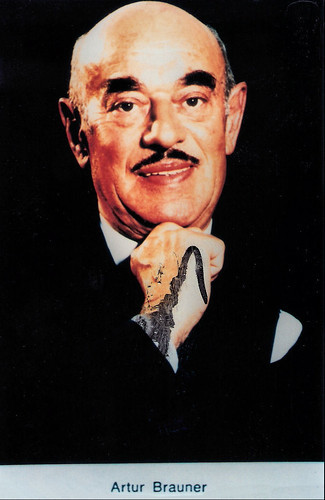
German autograph card.

German postcard by Kunst und Bild, Berlin, no. A 1336. Photo: CCC / Gloria / Arthur Grimm. Luis Mariano in Der Zarewitsch/The Little Czar (Arthur Maria Rabenalt, 1954).
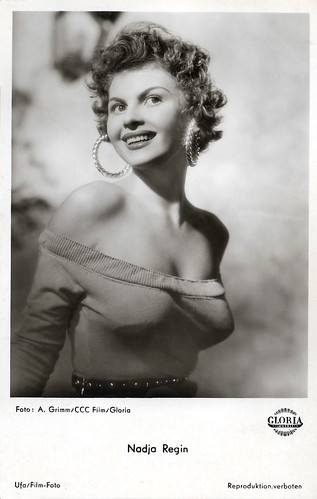
German postcard by Ufa/Film-Foto, no. I 240. Photo: A. Grimm / CCC Film / Gloria. Nadja Regin in Roman eines Frauenarztes/Novel of a gynaecologist (Falk Harnack, 1954).

West-German postcard by Kolibri-Verlag, no. 1622. Photo: CCC / Gloria / Arthur Grimm. Ingrid Lutz in Du mein stilles Tal/You my quiet valley (Leonard Steckel, 1955).

German postcard by Kunst und Bild, Berlin, no. F 10. Photo: A. Grimm / CCC / Deutsche London. Angelika Meissner in Der erste Frühlingstag/The first day of spring (Helmut Weiss, 1956).
A revival of Dr. Mabuse
Artur Brauner was born Abraham Brauner, the oldest son of a Jewish family, in Łódź, Lódzkie, Poland in 1918. His father was a timber wholesaler. His brother was the later producer and production manager Wolf Brauner.
Brauner attended a general education liceum in Łódź, where he took the matura final exam, and then studied at a local polytechnic technical school. As a young man, he saw Fritz Lang's film Das Testament der Dr. Mabuse/The Testament of Dr. Mabuse (1933), which affected him greatly, making him interested in film.
After the Nazis attacked Poland in September 1939, he and his parents and four siblings were forced to flee. The family moved to the Soviet Union, thus escaping the fate of other family members who were murdered in the massacres by German forces at Babi Yar in Ukraine.
After the war, his parents and three of his siblings emigrated to Israel. Despite his plans to emigrate to the United States, Brauner founded in 1946 his production company Central Cinema Company (CCC) in the American sector of Berlin.
His first production was the romantic comedy Sag' die Wahrheit/Tell the truth (Helmut Weiss, 1946) with Gustav Fröhlich and Mady Rahl . Brauner was the associate producer. Such popular films enabled him to produce films on topics close to his heart, including a number on the Holocaust.
As early as 1948, Brauner made Morituri (Eugen York, 1948), a film about the escape of prisoners from a concentration camp. It was a commercial failure and threw him into debt. Brauner realised that to produce critically successful films he had to make up their losses by producing critically derided films that were appreciated by the public.
With his brother Wolf, he built a career producing a seemingly relentless backbeat of music films, medical dramas, Westerns, tales of youthful rebellion and Heimatfilms. He lured back many Germans who had experience in Hollywood such as Robert Siodmak. His film Der 20. Juli/The Plot to Assassinate Hitler (Falk Harnack, 1955) was a fictionalised recounting of the failed attempt by Claus von Stauffenberg to kill Adolf Hitler in 1944. The film won several German awards.
Brauner convinced the German director Fritz Lang to return to Germany from Hollywood for a sequel to Das Testament der Dr. Mabuse/The Testament of Dr. Mabuse (1933), a film that the Nazis had banned. The sequel, Die 1000 Augen des Dr. Mabuse/The Thousand Eyes of Dr. Mabuse (1960) with Dawn Addams and Peter van Eyck , was the last film directed by Lang. It started a revival of Dr. Mabuse.
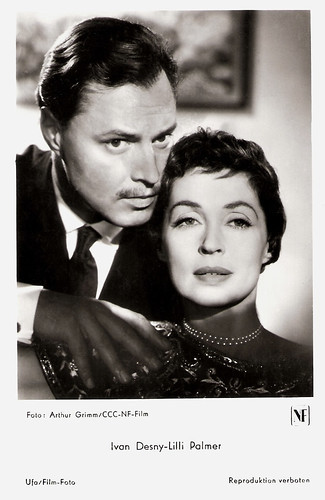
German postcard by Ufa, Wanne-Eickel, no. 393. Photo: Arthur Grimm / CCC / NF-Film. Ivan Desny and Lilli Palmer in Anastasia - Die letzte Zarentochter/Anastasia: The Czar's Last Daughter (Falk Harnack, 1956).
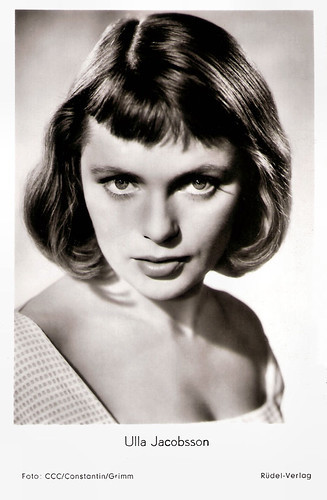
German postcard by Rüdel-Verlag, no. 1999. Photo: CCC / Constantin-Film / Grimm. Ulla Jacobsson in Die Letzten werden die Ersten sein/The Last Ones Shall Be First (Rolf Hansen, 1957).
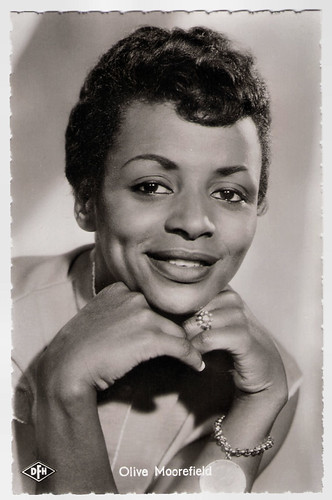
German postcard by Kolibri-Verlag G.m.b.H., Minden/Westf., no. 2644. Photo: CCC / Deutsche Film Hansa (DFH) / Arthur Grimm. Olive Moorefield in Einmal eine grosse Dame sein/To be a great lady for once (Erik Ode, 1957).
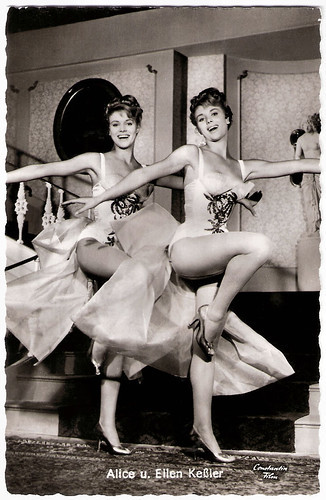
German postcard by Kolibri Verlag G.m.b.H, Minden/Westf., no. 2797. Photo: CCC / Constantin Film/ Arthur Grimm. Alice & Ellen Kessler in Der Graf von Luxemburg/The Count of Luxemburg (Werner Jacobs, 1957).

German postcard by Rüdel-Verlag, Hamburg-Bergedorff, no. 2866. Photo: CCC / Deutsche Film Hansa / Grimm. Horst Frank in Abschied von den Wolken/Rebel Flight to Cuba (Gottfried Reinhardt, 1959).
Capturing the emotional range and contradictions of postwar West Germany
Artur Brauner did much to keep Germans entertained through the decades after the second world war — and also made sure that they did not ignore the dark realities of their history that he had experienced at first hand.
He co-produced Il giardino dei Finzi Contini/The Garden of the Finzi-Continis (Vittorio De Sica, 1971), starring Dominique Sanda and Helmut Berger . The film was based on Giorgio Bassani’s book about a Jewish family in 1930s fascist Italy. It won an Academy Award for best foreign film.
His film Die Weisse Rose/The White Rose (Michael Verhoeven, 1982), starring Lena Stolze, told the story of a German anti-fascist resistance group whose leaders were guillotined by the Nazis in 1943.
In 1992, Brauner produced Europa Europa, Agnieszka Holland’s film about a Jewish boy who disguised himself as a Hitler Youth to survive the war. The film, based on the autobiography of Solomon Perel, was nominated for an Oscar and won a Golden Globe award.
Brauner also produced and co-wrote Babij Jar (Jeff Kanew, 2003), a film about the Babi Yar massacres, where many of his own relatives had been killed. According to the U.S. Holocaust Memorial Museum, about 100,000 people were murdered there.
In 2010, the Yad Vashem Holocaust memorial in Israel named a new media centre for Brauner. He reportedly called the recognition “the crowning achievement of my film career.”
Last year he allowed director Dominik Kuhn to re-work Fritz Lang's Die 1000 Augen des Dr. Mabuse (1960). Kuhn is known in the German-speaking world as 'Dodokay' from his comedic dubs in Swabian (a south German accent) on YouTube. He completely re-cut the film, shot additional footage, re-formatted it to 2.35:1, fitted the new version with a new story line, visual effects, new sound design, a score by Dennis Le Rose and finally dubbed all the original voices himself. The result was the comedy Die 1000 Glotzböbbel vom Dr. Mabuse (2018).
On 7 July 2019, Artur Brauner died in Berlin, Germany at the age of 100. He had been married to costume designer Maria Brauner-Stammgast, from 1947 till her death in 2017. They had four children, including the film producer Alice Brauner. Over the years, Artur Brauner’s company Central Cinema Company Film (CCC) produced over 700 films and TV programs. Brauner was a recipient of the Bundesverdienstkreuz. At the 2003 Berlinale, he was awarded the Berlinale Kamera honouring his lifetime achievement.
Frederick Studemann in The Financial Times: "Brauner is remembered for capturing the emotional range and contradictions of postwar West Germany — from memory and suppression, thrill-seeking and modernity, to the desire for harmony and homeliness — all the while reminding fellow citizens of recently perpetrated horrors."

German postcard by Franz Josef Rüdel, Filmpostkartenverlag, Hamburg-Bergedorf, no. FT 20. Photo: CCC / Gloria-Film / Grimm. Carlos Thompson in Franziska (Wolfgang Liebeneiner, 1957).
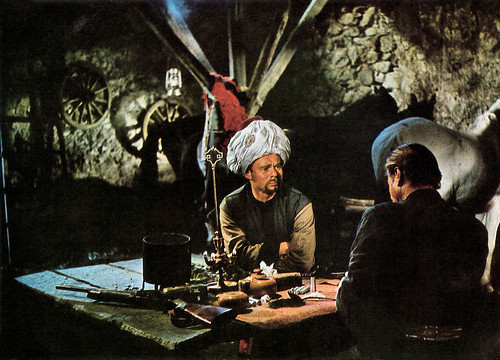
German postcard by Heinerle Karl-May-Postkarten, no. 15. Photo: CCC / Gloria. Lex Barker and Ralf Wolter in Der Schut/The Yellow One (Robert Siodmak, 1964). Caption: "Am Abend im Hause Galingré: 'Halef, ich werde dem Mübarek einen Streich spielen. Deshalb musstest du mir Wismut und Quecksilber besorgen. Daraus mache ich Kugeln, die genau aussehen wie Bleikugeln, aber beim Schiessen zerfallen. Nun lade ich das Gewehr immer abwechselnd mit einer Kugel aus Blei und mit einer falschen...''" (In the evening at home Galingré: "Halef, I will play a trick on the Mübarek. Therefore, you had to get me bismuth and mercury. From this I''ll make bullets that look like lead bullets, but disintegrate during firing. Now I'll load the gun alternately with a bullet made of lead and a fake one ...")

German postcard, no. 23 (1-36). Photo: CCC Produktion / Constantin. Guy Madison in Old Shatterhand (Hugo Fregonese, 1964). Caption: "Captain Bradley ist der neue Kommandant von Fort Grant." (Captain Bradley is the new commander of Fort Grant).

German postcard, no. 15. Photo: CCC / Constantin Film. Publicity still for Die Nibelungen, Teil 1 - Siegfried / Siegfried (Harald Reinl, 1967) with Uwe Beyer as Siegfried and Siegfried Wischnewski as Hagen. Caption: "Hagen überredet König Gunther, zu Siegfrieds Abschied einen Jagdausflug zu veranstalten. Unter dem Vorwand, Siegfried eine nahe gelegene Quelle zu zeigen, lockt Hagen mit des Königs wissen diesen von der Jagdgesellschaft weg. Als sich Siegfried, Erfrischung suchend, über die Quelle neigt, trifft ihn Hagens wohlgezielter Speer an der verwundbaren Stelle. Vergebens bäumt sich Siegfried noch einmal auf." (Hagen persuades King Gunther to organise a hunting trip as Siegfried's farewell. Under the pretext of showing Siegfried a nearby source, Hagen lures with the king know, him off the hunt. When Siegfried, searching for refreshment, leans over the source Hagen's well-aimed spear hits him on the vulnerable spot. In vain Siegfried rears up again. ")
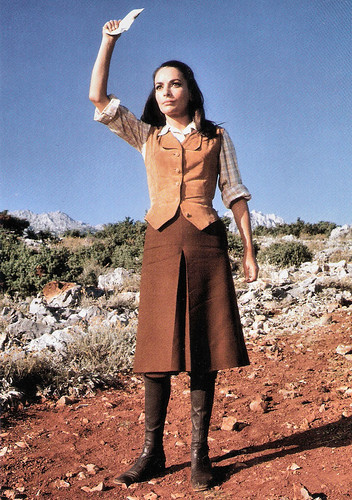
German postcard, no. 15 (1-36). Photo: CCC / Constantin. Karin Dor in Winnetou und Shatterhand im Tal der Toten/The Valley of Death (Harald Reinl, 1968). Caption: Mabel wants to give the letter to the bandits to save Lieutenant Cummings.
Sources: Toby Axelrod (The Jerusalem Post), Frederick Studemann (Financial Times), Wikipedia and .

German autograph card.

German postcard by Kunst und Bild, Berlin, no. A 1336. Photo: CCC / Gloria / Arthur Grimm. Luis Mariano in Der Zarewitsch/The Little Czar (Arthur Maria Rabenalt, 1954).

German postcard by Ufa/Film-Foto, no. I 240. Photo: A. Grimm / CCC Film / Gloria. Nadja Regin in Roman eines Frauenarztes/Novel of a gynaecologist (Falk Harnack, 1954).

West-German postcard by Kolibri-Verlag, no. 1622. Photo: CCC / Gloria / Arthur Grimm. Ingrid Lutz in Du mein stilles Tal/You my quiet valley (Leonard Steckel, 1955).

German postcard by Kunst und Bild, Berlin, no. F 10. Photo: A. Grimm / CCC / Deutsche London. Angelika Meissner in Der erste Frühlingstag/The first day of spring (Helmut Weiss, 1956).
A revival of Dr. Mabuse
Artur Brauner was born Abraham Brauner, the oldest son of a Jewish family, in Łódź, Lódzkie, Poland in 1918. His father was a timber wholesaler. His brother was the later producer and production manager Wolf Brauner.
Brauner attended a general education liceum in Łódź, where he took the matura final exam, and then studied at a local polytechnic technical school. As a young man, he saw Fritz Lang's film Das Testament der Dr. Mabuse/The Testament of Dr. Mabuse (1933), which affected him greatly, making him interested in film.
After the Nazis attacked Poland in September 1939, he and his parents and four siblings were forced to flee. The family moved to the Soviet Union, thus escaping the fate of other family members who were murdered in the massacres by German forces at Babi Yar in Ukraine.
After the war, his parents and three of his siblings emigrated to Israel. Despite his plans to emigrate to the United States, Brauner founded in 1946 his production company Central Cinema Company (CCC) in the American sector of Berlin.
His first production was the romantic comedy Sag' die Wahrheit/Tell the truth (Helmut Weiss, 1946) with Gustav Fröhlich and Mady Rahl . Brauner was the associate producer. Such popular films enabled him to produce films on topics close to his heart, including a number on the Holocaust.
As early as 1948, Brauner made Morituri (Eugen York, 1948), a film about the escape of prisoners from a concentration camp. It was a commercial failure and threw him into debt. Brauner realised that to produce critically successful films he had to make up their losses by producing critically derided films that were appreciated by the public.
With his brother Wolf, he built a career producing a seemingly relentless backbeat of music films, medical dramas, Westerns, tales of youthful rebellion and Heimatfilms. He lured back many Germans who had experience in Hollywood such as Robert Siodmak. His film Der 20. Juli/The Plot to Assassinate Hitler (Falk Harnack, 1955) was a fictionalised recounting of the failed attempt by Claus von Stauffenberg to kill Adolf Hitler in 1944. The film won several German awards.
Brauner convinced the German director Fritz Lang to return to Germany from Hollywood for a sequel to Das Testament der Dr. Mabuse/The Testament of Dr. Mabuse (1933), a film that the Nazis had banned. The sequel, Die 1000 Augen des Dr. Mabuse/The Thousand Eyes of Dr. Mabuse (1960) with Dawn Addams and Peter van Eyck , was the last film directed by Lang. It started a revival of Dr. Mabuse.

German postcard by Ufa, Wanne-Eickel, no. 393. Photo: Arthur Grimm / CCC / NF-Film. Ivan Desny and Lilli Palmer in Anastasia - Die letzte Zarentochter/Anastasia: The Czar's Last Daughter (Falk Harnack, 1956).

German postcard by Rüdel-Verlag, no. 1999. Photo: CCC / Constantin-Film / Grimm. Ulla Jacobsson in Die Letzten werden die Ersten sein/The Last Ones Shall Be First (Rolf Hansen, 1957).

German postcard by Kolibri-Verlag G.m.b.H., Minden/Westf., no. 2644. Photo: CCC / Deutsche Film Hansa (DFH) / Arthur Grimm. Olive Moorefield in Einmal eine grosse Dame sein/To be a great lady for once (Erik Ode, 1957).

German postcard by Kolibri Verlag G.m.b.H, Minden/Westf., no. 2797. Photo: CCC / Constantin Film/ Arthur Grimm. Alice & Ellen Kessler in Der Graf von Luxemburg/The Count of Luxemburg (Werner Jacobs, 1957).

German postcard by Rüdel-Verlag, Hamburg-Bergedorff, no. 2866. Photo: CCC / Deutsche Film Hansa / Grimm. Horst Frank in Abschied von den Wolken/Rebel Flight to Cuba (Gottfried Reinhardt, 1959).
Capturing the emotional range and contradictions of postwar West Germany
Artur Brauner did much to keep Germans entertained through the decades after the second world war — and also made sure that they did not ignore the dark realities of their history that he had experienced at first hand.
He co-produced Il giardino dei Finzi Contini/The Garden of the Finzi-Continis (Vittorio De Sica, 1971), starring Dominique Sanda and Helmut Berger . The film was based on Giorgio Bassani’s book about a Jewish family in 1930s fascist Italy. It won an Academy Award for best foreign film.
His film Die Weisse Rose/The White Rose (Michael Verhoeven, 1982), starring Lena Stolze, told the story of a German anti-fascist resistance group whose leaders were guillotined by the Nazis in 1943.
In 1992, Brauner produced Europa Europa, Agnieszka Holland’s film about a Jewish boy who disguised himself as a Hitler Youth to survive the war. The film, based on the autobiography of Solomon Perel, was nominated for an Oscar and won a Golden Globe award.
Brauner also produced and co-wrote Babij Jar (Jeff Kanew, 2003), a film about the Babi Yar massacres, where many of his own relatives had been killed. According to the U.S. Holocaust Memorial Museum, about 100,000 people were murdered there.
In 2010, the Yad Vashem Holocaust memorial in Israel named a new media centre for Brauner. He reportedly called the recognition “the crowning achievement of my film career.”
Last year he allowed director Dominik Kuhn to re-work Fritz Lang's Die 1000 Augen des Dr. Mabuse (1960). Kuhn is known in the German-speaking world as 'Dodokay' from his comedic dubs in Swabian (a south German accent) on YouTube. He completely re-cut the film, shot additional footage, re-formatted it to 2.35:1, fitted the new version with a new story line, visual effects, new sound design, a score by Dennis Le Rose and finally dubbed all the original voices himself. The result was the comedy Die 1000 Glotzböbbel vom Dr. Mabuse (2018).
On 7 July 2019, Artur Brauner died in Berlin, Germany at the age of 100. He had been married to costume designer Maria Brauner-Stammgast, from 1947 till her death in 2017. They had four children, including the film producer Alice Brauner. Over the years, Artur Brauner’s company Central Cinema Company Film (CCC) produced over 700 films and TV programs. Brauner was a recipient of the Bundesverdienstkreuz. At the 2003 Berlinale, he was awarded the Berlinale Kamera honouring his lifetime achievement.
Frederick Studemann in The Financial Times: "Brauner is remembered for capturing the emotional range and contradictions of postwar West Germany — from memory and suppression, thrill-seeking and modernity, to the desire for harmony and homeliness — all the while reminding fellow citizens of recently perpetrated horrors."

German postcard by Franz Josef Rüdel, Filmpostkartenverlag, Hamburg-Bergedorf, no. FT 20. Photo: CCC / Gloria-Film / Grimm. Carlos Thompson in Franziska (Wolfgang Liebeneiner, 1957).

German postcard by Heinerle Karl-May-Postkarten, no. 15. Photo: CCC / Gloria. Lex Barker and Ralf Wolter in Der Schut/The Yellow One (Robert Siodmak, 1964). Caption: "Am Abend im Hause Galingré: 'Halef, ich werde dem Mübarek einen Streich spielen. Deshalb musstest du mir Wismut und Quecksilber besorgen. Daraus mache ich Kugeln, die genau aussehen wie Bleikugeln, aber beim Schiessen zerfallen. Nun lade ich das Gewehr immer abwechselnd mit einer Kugel aus Blei und mit einer falschen...''" (In the evening at home Galingré: "Halef, I will play a trick on the Mübarek. Therefore, you had to get me bismuth and mercury. From this I''ll make bullets that look like lead bullets, but disintegrate during firing. Now I'll load the gun alternately with a bullet made of lead and a fake one ...")

German postcard, no. 23 (1-36). Photo: CCC Produktion / Constantin. Guy Madison in Old Shatterhand (Hugo Fregonese, 1964). Caption: "Captain Bradley ist der neue Kommandant von Fort Grant." (Captain Bradley is the new commander of Fort Grant).

German postcard, no. 15. Photo: CCC / Constantin Film. Publicity still for Die Nibelungen, Teil 1 - Siegfried / Siegfried (Harald Reinl, 1967) with Uwe Beyer as Siegfried and Siegfried Wischnewski as Hagen. Caption: "Hagen überredet König Gunther, zu Siegfrieds Abschied einen Jagdausflug zu veranstalten. Unter dem Vorwand, Siegfried eine nahe gelegene Quelle zu zeigen, lockt Hagen mit des Königs wissen diesen von der Jagdgesellschaft weg. Als sich Siegfried, Erfrischung suchend, über die Quelle neigt, trifft ihn Hagens wohlgezielter Speer an der verwundbaren Stelle. Vergebens bäumt sich Siegfried noch einmal auf." (Hagen persuades King Gunther to organise a hunting trip as Siegfried's farewell. Under the pretext of showing Siegfried a nearby source, Hagen lures with the king know, him off the hunt. When Siegfried, searching for refreshment, leans over the source Hagen's well-aimed spear hits him on the vulnerable spot. In vain Siegfried rears up again. ")

German postcard, no. 15 (1-36). Photo: CCC / Constantin. Karin Dor in Winnetou und Shatterhand im Tal der Toten/The Valley of Death (Harald Reinl, 1968). Caption: Mabel wants to give the letter to the bandits to save Lieutenant Cummings.
Sources: Toby Axelrod (The Jerusalem Post), Frederick Studemann (Financial Times), Wikipedia and .
Published on July 11, 2019 22:00
July 10, 2019
Valentina Cortese dies at 96
Yesterday, Wednesday 10 July 2019, Italian film and stage actress Valentina Cortese (1923-2019) has passed away in Milan. She appeared in more than 100 Italian, French, British and American films and TV series. Cortese was nominated for the Oscar for Best Supporting Actress for her role in François Truffaut’s La nuit américaine/Day for Night (1973). She also worked with such titans of cinema as Michelangelo Antonioni and Federico Fellini. Valentina Cortese was 96.
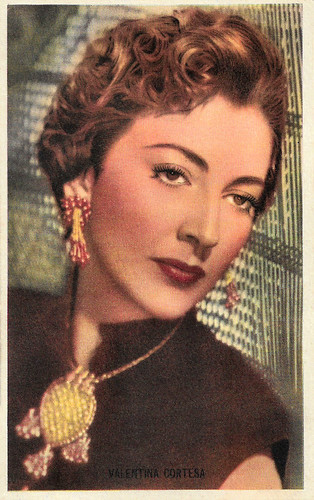
Belgian collectors card by Kwatta, no. C. 243. Photo: MGM. Valentina Cortese in Malaya (Richard Thorpe, 1949).

Italian postcard by ASER, Roma, no. 48. Photo: Scalera Film.
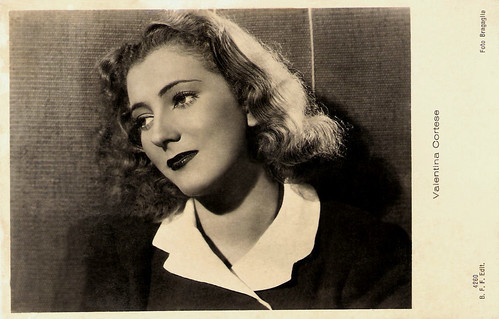
Italian postcard by Casa Editr. Ballerini & Fratini (B.F.F. Edit.), Firenze, no. 4260. Photo: Bragaglia.

Italian postcard. B.F.F. (Ballerini & Fratini Firenze) Edizioni, no. 42290. Photo: Pesce / I.C.I.
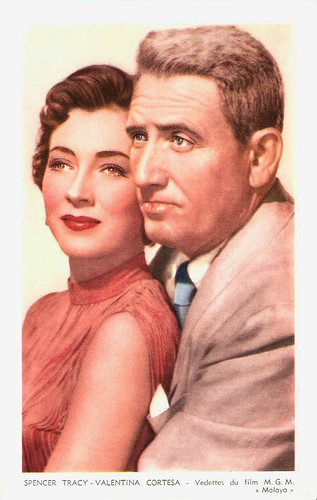
Belgian collectors card. Photo: MGM. Spencer Tracy and Valentina Cortesa in Malaya (1949).
Sensual Prostitute With A Golden Heart
Valentina Cortese was born in Milan, Italy in 1923. As a young girl she attended the acting school of Scalera Film.
She started her film career in 1940 and played small ingenue parts in such films as Orizzonte dipinto/Horizon painting (Guido Salvini, 1941), L'Attore scomparso/The actor died (Luigi Zampa, 1941) and Primo Amore/First Love (Carmine Gallone, 1941) with Vivi Gioi .
The following year, she had her breakthrough with a supporting part in the Western Una signora dell'Ovest/Girl of the Golden West (Carl Koch, 1942) with Michel Simon . She soon became one of the most popular actresses of the fascist period/
Cortese appeared in several entertainment films of the 1940s, including La Cena delle beffe/The Joker’s Dinner (Alessandro Blasetti, 1942) starring Amedeo Nazzari , Quarta pagina/3/4 of a Page (Nicola Manzari, 1942) based on an original screenplay by Federico Fellini, Nessuno torna indietro/Responsibility Comes Back (Alessandro Blasetti, 1945), and Un Americano in vacanza/A Yank in Rome (Luigi Zampa, 1946).
A sensation was her double role as both Fantine and Cosette in I miserabili/Les Miserables (Riccardo Freda, 1948), a competent screen adaptation of the Victor Hugo classic.
The international success of the British-French melodrama The Glass Mountain (Henry Cass, 1949) brought her a Hollywood offer from 20th Century Fox. Studio mogul Darryl F. Zanuck emphasised her Mediterranean background by changing the spelling of her name to Cortesa.
She appeared as a sensual prostitute with a golden heart in Jules Dassin's Thieves' Highway (1949). Other American productions were Black Magic (Gregory Ratoff, 1949) with Orson Welles , and Malaya (Richard Thorpe, 1949) with Spencer Tracey and James Stewart.
She portrayed a girl pursued by a killer in the thriller The House on Telegraph Hill (1951, Robert Wise). Her co-star was Richard Basehart , whom she married that same year. She had one son with him before they divorced in 1960.
Cortese returned to Europe and worked with such great directors as Michelangelo Antonioni, who cast her in his Le amiche/The Girlfriends (1955) with Eleonora Rossi Drago , and Federico Fellini, who gave her a supporting part in his surrealist fantasy Giulietta degli spiriti/Juliet of the Spirits (1965) starring Giulietta Masina .
For her role in Le Amiche she won a Nastro d’argento (Silver Ribbon) for Best Supporting Actress. During these years she also appeared in such international films as The Barefoot Contessa (Joseph L. Mankiewicz, 1954) in which she played Countess Eleanora Torlato-Favrini, Magic Fire (William Dieterle, 1955), Barabba/Barabbas (Richard Fleischer, 1961) starring Anthony Quinn , and The Visit (Bernhard Wicki, 1964) with Ingrid Bergman .

Italian postcard by B.F.F. Edit. (Ballerini & Fratini Firenze Edizioni), no. 4306. Photo: Scalera Film / Foto Pesce.

Italian postcard by B.F.F. Edit. (Ballerini & Fratini Firenze Edizioni), no. 4311. Photo: E.N.I.C. / Foto Vaselli.
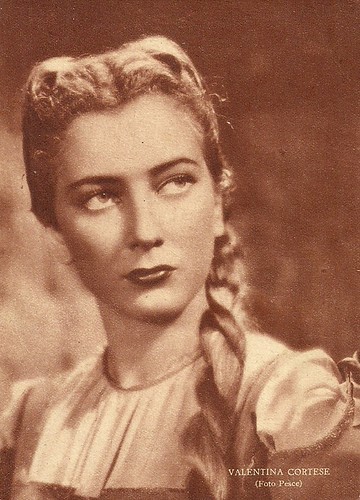
Italian postcard by Rizzoli, Milano, 1942. Photo: Pesce. Valentina Cortese as Lisabetta in La cena delle beffe/The Jester's Supper (Alessandro Blasetti, 1942).

British postcard by Picturegoer, no. 785. Photo: 20th Century Fox. Cortese is named Cortesa, the name often given to her in Hollywood. At Fox, Cortese did films such as Thieves' Highway (Jules Dassin, 1949).
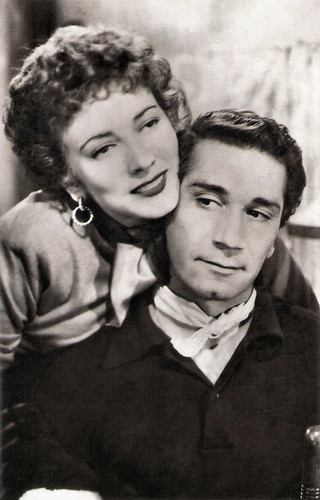
Spanish postcard by Sobe, no. 638. Valentina Cortese and Richard Conte in Thieves' Highway (Jules Dassin, 1949).
Fading, Alcoholic Film Star
Valentina Cortese did some of her finest work in her middle years. She gave a memorable performance as a fading, alcoholic film star, who can’t remember her lines, in François Truffaut's film-about-film La nuit américaine/Day for Night (1973).
She won several awards for this bravura role including the British Bafta award. In the US she was nominated for both a Golden Globe and the Oscar. When Ingrid Bergman won for her small role in Murder on the Orient Express (Sidney Lumet, 1976), Bergman apologised in her acceptance speech, saying that Cortese deserved the award more.
Other interesting performances by Cortese were the exalted mother in Le bateau sur l’herbe/The Boat on the Grass (Gérard Brach, 1971), and the wife of Leon Trotzky ( Richard Burton ) in The Assassination of Trotsky (Joseph Losey, 1973).
For director Franco Zeffirelli, she played the mother of St. Francis of Assisi in Fratello Sole, sorella luna/Brother Sun, Sister Moon (Franco Zeffirelli, 1972). Later followed several parts in the theaterre for Zeffirelli and a role as Herodias in his TV Mini-Series Jesus of Nazareth (Franco Zeffirelli, 1977), an uncredited part in Il giovane Toscanini/Toscanini (Franco Zeffirelli, 1988) a biopic of legendary conductor Arturo Toscanini, and her final role as a mother superior in Storia di una capinera/Sparrow (Franco Zeffirelli, 1995) with Johnathon Schaech.
Her later films also included the adventure film When Time Ran Out... (James Goldstone, 1980) starring Paul Newman, Terry Gilliam's The Adventures of Baron Munchausen (1988), and the comedy Buster’s Bedroom (Rebecca Horn, 1991) with Geraldine Chaplin .
Valentina Cortese also had a fruitful stage career, working with directors like Giorgio Strehler and starring in plays like Friedrich Schiller's Mary Stuart and Frank Wedekind's Lulu. Her son, Jackie Basehart, also became an actor and appeared in several Italian films.

British (or American) postcard. Photo: MGM. Cortese is presented as Cortesa, the name she was often given in Hollywood. Cortese wears a dress from the time of Malaya (Richard Thorpe, 1949), a film she did with James Stewart and Spencer Tracy.
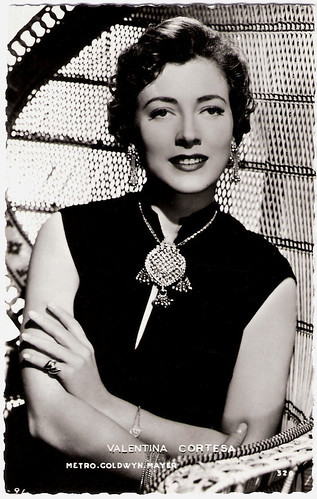
French postcard by Editions P.I., Paris, no. 32. Photo: Metro-Goldwyn-Mayer, 1954.
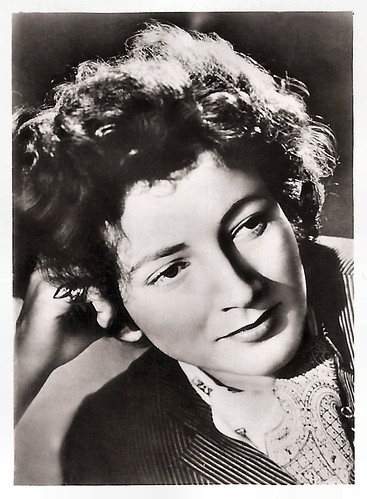
West-German collectors card in the Flmstars der Welt series by Greiling-Sammelbilder, 2. Band, Serie E, Bild 99. Photo: 20th Century Fox.
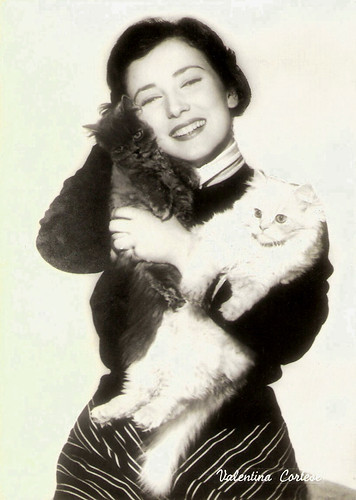
Italian postcard by Bromofoto, Milano, no. 399.
Theatrical trailer Thieves' Highway (1949). Source: Diva Daniela 1 (YouTube).
Trailer for Giulietta degli spiriti/Juliet of the Spirits (1965). Source: Danios 12345 (YouTube).
Scene from La nuit américaine/Day for Night (1973). Source: The Bathroom Singer (YouTube).
Sources: Hal Erickson (AllMovie), (IMDb), Trova Cinema (Italian), Wikipedia and .

Belgian collectors card by Kwatta, no. C. 243. Photo: MGM. Valentina Cortese in Malaya (Richard Thorpe, 1949).

Italian postcard by ASER, Roma, no. 48. Photo: Scalera Film.

Italian postcard by Casa Editr. Ballerini & Fratini (B.F.F. Edit.), Firenze, no. 4260. Photo: Bragaglia.

Italian postcard. B.F.F. (Ballerini & Fratini Firenze) Edizioni, no. 42290. Photo: Pesce / I.C.I.

Belgian collectors card. Photo: MGM. Spencer Tracy and Valentina Cortesa in Malaya (1949).
Sensual Prostitute With A Golden Heart
Valentina Cortese was born in Milan, Italy in 1923. As a young girl she attended the acting school of Scalera Film.
She started her film career in 1940 and played small ingenue parts in such films as Orizzonte dipinto/Horizon painting (Guido Salvini, 1941), L'Attore scomparso/The actor died (Luigi Zampa, 1941) and Primo Amore/First Love (Carmine Gallone, 1941) with Vivi Gioi .
The following year, she had her breakthrough with a supporting part in the Western Una signora dell'Ovest/Girl of the Golden West (Carl Koch, 1942) with Michel Simon . She soon became one of the most popular actresses of the fascist period/
Cortese appeared in several entertainment films of the 1940s, including La Cena delle beffe/The Joker’s Dinner (Alessandro Blasetti, 1942) starring Amedeo Nazzari , Quarta pagina/3/4 of a Page (Nicola Manzari, 1942) based on an original screenplay by Federico Fellini, Nessuno torna indietro/Responsibility Comes Back (Alessandro Blasetti, 1945), and Un Americano in vacanza/A Yank in Rome (Luigi Zampa, 1946).
A sensation was her double role as both Fantine and Cosette in I miserabili/Les Miserables (Riccardo Freda, 1948), a competent screen adaptation of the Victor Hugo classic.
The international success of the British-French melodrama The Glass Mountain (Henry Cass, 1949) brought her a Hollywood offer from 20th Century Fox. Studio mogul Darryl F. Zanuck emphasised her Mediterranean background by changing the spelling of her name to Cortesa.
She appeared as a sensual prostitute with a golden heart in Jules Dassin's Thieves' Highway (1949). Other American productions were Black Magic (Gregory Ratoff, 1949) with Orson Welles , and Malaya (Richard Thorpe, 1949) with Spencer Tracey and James Stewart.
She portrayed a girl pursued by a killer in the thriller The House on Telegraph Hill (1951, Robert Wise). Her co-star was Richard Basehart , whom she married that same year. She had one son with him before they divorced in 1960.
Cortese returned to Europe and worked with such great directors as Michelangelo Antonioni, who cast her in his Le amiche/The Girlfriends (1955) with Eleonora Rossi Drago , and Federico Fellini, who gave her a supporting part in his surrealist fantasy Giulietta degli spiriti/Juliet of the Spirits (1965) starring Giulietta Masina .
For her role in Le Amiche she won a Nastro d’argento (Silver Ribbon) for Best Supporting Actress. During these years she also appeared in such international films as The Barefoot Contessa (Joseph L. Mankiewicz, 1954) in which she played Countess Eleanora Torlato-Favrini, Magic Fire (William Dieterle, 1955), Barabba/Barabbas (Richard Fleischer, 1961) starring Anthony Quinn , and The Visit (Bernhard Wicki, 1964) with Ingrid Bergman .

Italian postcard by B.F.F. Edit. (Ballerini & Fratini Firenze Edizioni), no. 4306. Photo: Scalera Film / Foto Pesce.

Italian postcard by B.F.F. Edit. (Ballerini & Fratini Firenze Edizioni), no. 4311. Photo: E.N.I.C. / Foto Vaselli.

Italian postcard by Rizzoli, Milano, 1942. Photo: Pesce. Valentina Cortese as Lisabetta in La cena delle beffe/The Jester's Supper (Alessandro Blasetti, 1942).

British postcard by Picturegoer, no. 785. Photo: 20th Century Fox. Cortese is named Cortesa, the name often given to her in Hollywood. At Fox, Cortese did films such as Thieves' Highway (Jules Dassin, 1949).

Spanish postcard by Sobe, no. 638. Valentina Cortese and Richard Conte in Thieves' Highway (Jules Dassin, 1949).
Fading, Alcoholic Film Star
Valentina Cortese did some of her finest work in her middle years. She gave a memorable performance as a fading, alcoholic film star, who can’t remember her lines, in François Truffaut's film-about-film La nuit américaine/Day for Night (1973).
She won several awards for this bravura role including the British Bafta award. In the US she was nominated for both a Golden Globe and the Oscar. When Ingrid Bergman won for her small role in Murder on the Orient Express (Sidney Lumet, 1976), Bergman apologised in her acceptance speech, saying that Cortese deserved the award more.
Other interesting performances by Cortese were the exalted mother in Le bateau sur l’herbe/The Boat on the Grass (Gérard Brach, 1971), and the wife of Leon Trotzky ( Richard Burton ) in The Assassination of Trotsky (Joseph Losey, 1973).
For director Franco Zeffirelli, she played the mother of St. Francis of Assisi in Fratello Sole, sorella luna/Brother Sun, Sister Moon (Franco Zeffirelli, 1972). Later followed several parts in the theaterre for Zeffirelli and a role as Herodias in his TV Mini-Series Jesus of Nazareth (Franco Zeffirelli, 1977), an uncredited part in Il giovane Toscanini/Toscanini (Franco Zeffirelli, 1988) a biopic of legendary conductor Arturo Toscanini, and her final role as a mother superior in Storia di una capinera/Sparrow (Franco Zeffirelli, 1995) with Johnathon Schaech.
Her later films also included the adventure film When Time Ran Out... (James Goldstone, 1980) starring Paul Newman, Terry Gilliam's The Adventures of Baron Munchausen (1988), and the comedy Buster’s Bedroom (Rebecca Horn, 1991) with Geraldine Chaplin .
Valentina Cortese also had a fruitful stage career, working with directors like Giorgio Strehler and starring in plays like Friedrich Schiller's Mary Stuart and Frank Wedekind's Lulu. Her son, Jackie Basehart, also became an actor and appeared in several Italian films.

British (or American) postcard. Photo: MGM. Cortese is presented as Cortesa, the name she was often given in Hollywood. Cortese wears a dress from the time of Malaya (Richard Thorpe, 1949), a film she did with James Stewart and Spencer Tracy.

French postcard by Editions P.I., Paris, no. 32. Photo: Metro-Goldwyn-Mayer, 1954.

West-German collectors card in the Flmstars der Welt series by Greiling-Sammelbilder, 2. Band, Serie E, Bild 99. Photo: 20th Century Fox.

Italian postcard by Bromofoto, Milano, no. 399.
Theatrical trailer Thieves' Highway (1949). Source: Diva Daniela 1 (YouTube).
Trailer for Giulietta degli spiriti/Juliet of the Spirits (1965). Source: Danios 12345 (YouTube).
Scene from La nuit américaine/Day for Night (1973). Source: The Bathroom Singer (YouTube).
Sources: Hal Erickson (AllMovie), (IMDb), Trova Cinema (Italian), Wikipedia and .
Published on July 10, 2019 22:00
July 9, 2019
New acquisitions: Zingari (1920)
Today the second post on postcards Ivo Blom acquired last month at the Il Cinema Ritrovato Book Fair in Bologna. It's a film special on the Italian silent drama Zingari/Gypsies (1920), starring diva Italia Almirante (Manzini) and directed by her husband, Mario Almirante for the film studio Fert Film. Italia Almirante played Vielka, daughter of the king of the gypsies.
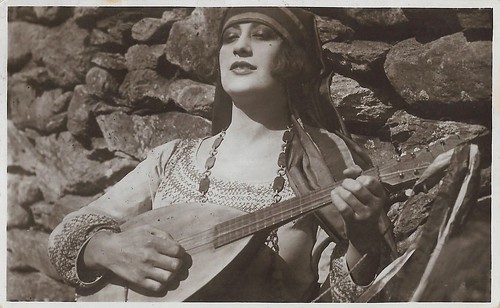
Italian postcard for Zingari (Mario Almirante, 1920), starring Italia Almirante Manzini .
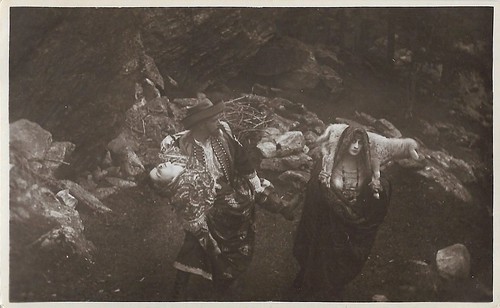
Italian postcard for Zingari (Mario Almirante, 1920). Caption: The first encounter of Vielka ( Italia Almirante ) and Sindel ( Amleto Novelli ). The woman Novelli carries may be Rosetta Solari, who plays Radscia.
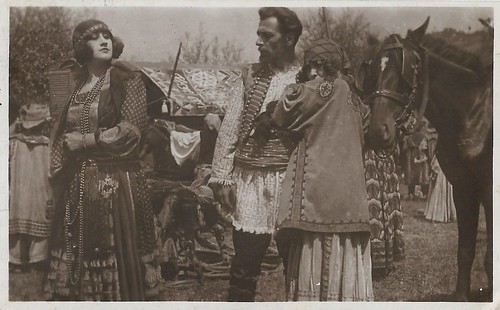
Italian postcard for Zingari (Mario Almirante, 1920). Caption: Vielka challenges Sindel. The second woman may be Rosetta Solari.
A warm, vigorous and deeply human performance
In Zingari/Gypsies (1920), Old Jammadar (Alfonso Cassini), king of the gypsies, wants to marry his daughter Vielka ( Italia Almirante ) to Gudlo (Franz Sala), member of an important and valuable clan, but also a violent and ambitious man.
Vielka, instead, loves the head of another clan, Sindel ( Amleto Novelli ). When Jammadar dies, Vielka is crowned queen of the gypsies. The proud Sindel distances himself of the woman out of fear to become a prince consort. The perfidious Gudlo wounds and betrays Sindel, but Vielka renounces her crown and thus regains Sindel's love, who chases Gudlo from the clan.
Zingari was produced by Fert Film and distributed by Pittaluga. The film was scripted and directed by Mario Almirante and photographed by Ubaldo Arata. It was one of Arata's first films. The active cinematographer did over 100 films between 1918 and 1947, including Roberto Rossellini's Roma città aperta/Rome, Open City (1945).
The film premiered on 27 December 1920. At the time, critics wrote mixed reviews. The Neapolitan Cine-Fono wrote that despite the luxurious mise-en-scene, script and direction were not top, while Italia Almirante was beautiful but too external and lacking psychology and her co-star Amleto Novelli was straight-jacked in his acting.
Instead, the Roman journal Febo wrote that despite well-known romantic elements, the story was solid, convincing and at times original. Also, the mise-en-scene was impeccable, faithful for the interiors, and picturesque for the exteriors - while the used film technology showed modernity and innovation. Among the performance of the actors in particular that of Italia Almirante was singled out as warm, vigorous and deeply human.
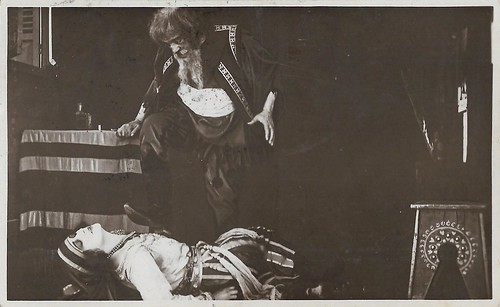
Italian postcard for Zingari (Mario Almirante, 1920). Caption: Jammadar (Alfonso Cassini) shouts to Vielka ( Italia Almirante ): I will crush you!
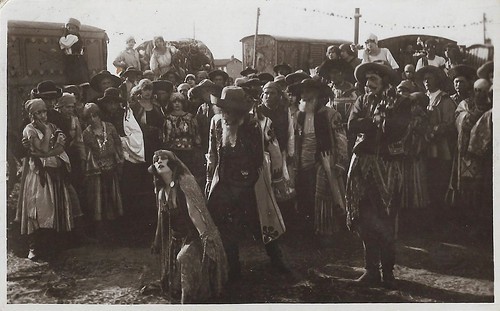
Italian postcard for Zingari (Mario Almirante, 1920). Caption: Jammadar forces Vielka to marry Gudlo.
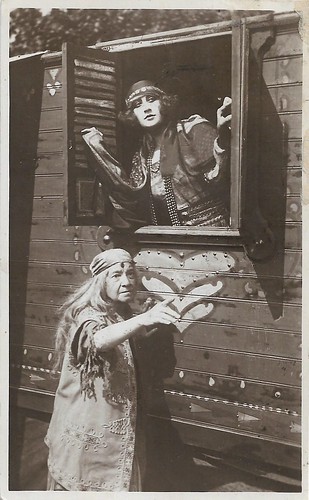
Italian postcard for Zingari (Mario Almirante, 1920). Caption: Vielka returns to the gypsy wagon.
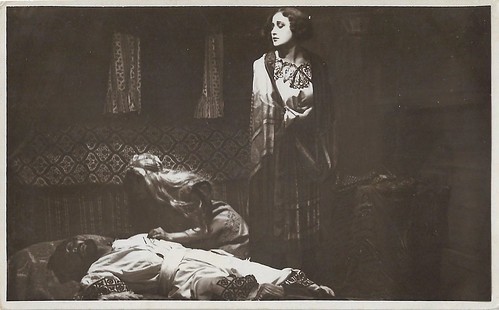
Italian postcard for Zingari (Mario Almirante, 1920). Caption: Vielka ( Italia Almirante ) tends to the wounded Sindel ( Amleto Novelli ) in her wagon.
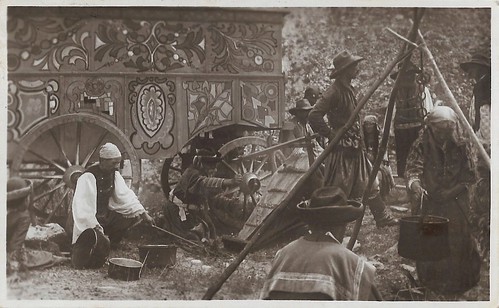
Italian postcard for Zingari (Mario Almirante, 1920). Caption: The gypsy camp.
Sources: Vittorio Martinelli (Il cinema muto italiano 1920 - Italian), Wikipedia (Italian and English) and IMDb.

Italian postcard for Zingari (Mario Almirante, 1920), starring Italia Almirante Manzini .

Italian postcard for Zingari (Mario Almirante, 1920). Caption: The first encounter of Vielka ( Italia Almirante ) and Sindel ( Amleto Novelli ). The woman Novelli carries may be Rosetta Solari, who plays Radscia.

Italian postcard for Zingari (Mario Almirante, 1920). Caption: Vielka challenges Sindel. The second woman may be Rosetta Solari.
A warm, vigorous and deeply human performance
In Zingari/Gypsies (1920), Old Jammadar (Alfonso Cassini), king of the gypsies, wants to marry his daughter Vielka ( Italia Almirante ) to Gudlo (Franz Sala), member of an important and valuable clan, but also a violent and ambitious man.
Vielka, instead, loves the head of another clan, Sindel ( Amleto Novelli ). When Jammadar dies, Vielka is crowned queen of the gypsies. The proud Sindel distances himself of the woman out of fear to become a prince consort. The perfidious Gudlo wounds and betrays Sindel, but Vielka renounces her crown and thus regains Sindel's love, who chases Gudlo from the clan.
Zingari was produced by Fert Film and distributed by Pittaluga. The film was scripted and directed by Mario Almirante and photographed by Ubaldo Arata. It was one of Arata's first films. The active cinematographer did over 100 films between 1918 and 1947, including Roberto Rossellini's Roma città aperta/Rome, Open City (1945).
The film premiered on 27 December 1920. At the time, critics wrote mixed reviews. The Neapolitan Cine-Fono wrote that despite the luxurious mise-en-scene, script and direction were not top, while Italia Almirante was beautiful but too external and lacking psychology and her co-star Amleto Novelli was straight-jacked in his acting.
Instead, the Roman journal Febo wrote that despite well-known romantic elements, the story was solid, convincing and at times original. Also, the mise-en-scene was impeccable, faithful for the interiors, and picturesque for the exteriors - while the used film technology showed modernity and innovation. Among the performance of the actors in particular that of Italia Almirante was singled out as warm, vigorous and deeply human.

Italian postcard for Zingari (Mario Almirante, 1920). Caption: Jammadar (Alfonso Cassini) shouts to Vielka ( Italia Almirante ): I will crush you!

Italian postcard for Zingari (Mario Almirante, 1920). Caption: Jammadar forces Vielka to marry Gudlo.

Italian postcard for Zingari (Mario Almirante, 1920). Caption: Vielka returns to the gypsy wagon.

Italian postcard for Zingari (Mario Almirante, 1920). Caption: Vielka ( Italia Almirante ) tends to the wounded Sindel ( Amleto Novelli ) in her wagon.

Italian postcard for Zingari (Mario Almirante, 1920). Caption: The gypsy camp.
Sources: Vittorio Martinelli (Il cinema muto italiano 1920 - Italian), Wikipedia (Italian and English) and IMDb.
Published on July 09, 2019 22:00
Paul van Yperen's Blog
- Paul van Yperen's profile
- 13 followers
Paul van Yperen isn't a Goodreads Author
(yet),
but they
do have a blog,
so here are some recent posts imported from
their feed.



